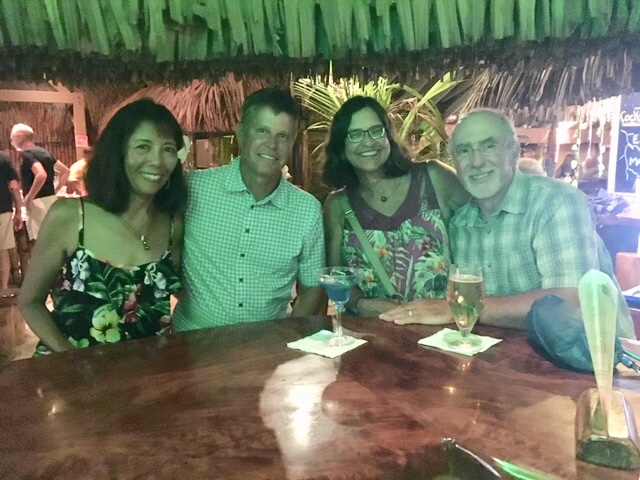
Here it is, May 26, our wedding anniversary. What have we been doing since I last updated our blog on April 10? Good question! Sitting inside our boat cabin being gently rolled on our mooring ball on Bora Bora by the unsettled weather outside, I feel like I have been doing nothing but whiling away the days and nights in a tropical paradise. Time slows down here. I am never in a hurry to do anything.
SNORKELING
For example, all I got written on this blog entry yesterday was the first paragraph. Just as I was writing it, the skies cleared, which was our call to don our snorkeling gear and head with Rob and Nancy from Shindig to a fabulous drift snorkeling spot nearby. Just as we got there, another young couple in a small skiff they rented from their resort came along and joined us. The drift was fun but a little scary – it wasn’t between two motus or in a pass like the other drifts we have done, so the boundaries were a little unclear. Instead, we dinghied as far east along the shoreline of Bora’s SE motu as we could before coming to a volcanic rock outcropping that paralleled the shore. There, we found a small buoy to tie off our dinghies. Afterwards, we walked SE along the volcanic rock for maybe 150 yards. Fortunately we had good shoes on to protect our feet and discourage slipping. To our right, between the island’s barrier reef and the volcanic rock strip, was a large expanse of some really fast moving water heading west over a shallow reef, maybe 5 feet deep or so. The current seemed to be coming from the wind and the breaking waves on the barrier reef to the east of us (there was a big swell in the ocean that day). I was a little concerned that the current was pushing towards the volcanic strip, because sets of large waves were breaking over the volcanic rock even as we walked along it. However, it turned out that if we just swam out a little ways once we climbed into the water off the volcanic rock, we were in no danger of being pushed against the rock.
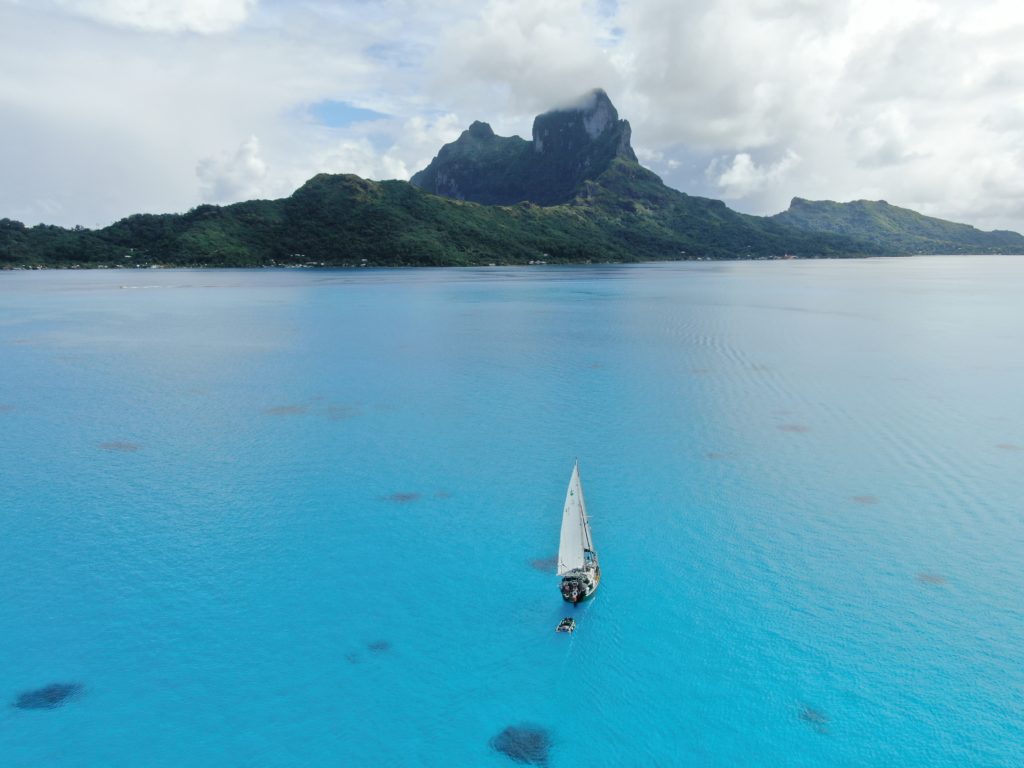
What a ride! The current was like a freight train. There wasn’t much chance to stop and linger over the beauty of the coral reef below, but of what I could see of it, the coral was much more diverse and healthier than what we have seen at more frequented snorkeling spots. The current was so strong, it was kind of like river kayaking under water with no kayak! You had to maneuver through the current to avoid underwater obstacles and find safe passage. We would watch under water for deeper passages through the reef up ahead and aim ourselves towards them to avoid getting snagged by coral outcroppings near the surface. More than once I had to round my back and suck up my stomach to avoid scraping! Rob calls it, “flattening out like a pancake.” At one point, Rick came swimming across my path in quite a hurry after he realized we had both drifted out away from the shore quite a distance and could be in danger of being swept away with the current; I got the hint and followed him to safer waters. It was quite the thrill. We did it twice.
Next we dinghied over to check out a wreck Rob knew about along the reef about a mile away, and then we dinghied back to the more popular snorkeling spot above the clusters of coral off the SE corner of the Sofitel Private Island resort. The day before, Rick and I had spent hours there, creating a message with stones in the shallow sand bottom for our niece Jen and her family. It read, “Loves Matters Most,” the phrase that has become the epithet for remembering her young son’s life, which tragically ended in 2017. We got the idea when we saw that someone else had written “Love Bora.” The huge variety of fish there are accustomed to being fed by the flocks of resort customers who are brought there daily on boating excursions, so as soon as you dive into the water, you are surrounded by fish who think they are going to get a free meal. Not very ecological, but what a great sensation to be surrounded by beautiful, exotic fish. Some of my favorites are the parrot fish, and what we think is probably a type of trigger fish, whose vibrant, contrasting colors look like they were painted on with a fine-tipped brush.
So, can you see now how our days just seem to melt away with the sun? Actually, the larger part of this last week has mostly been spent inside Cool Change’s cabin due to inclement weather. The rainy, gusty weather with grey skies and frequent squalls usually lasts for about one week followed by sunny, hot days with little wind for another week, but over the last two months we have been here, this is only the second episode I can remember of such extended inclement weather. I am not sure we will see blue skies at all today, and the wind has not ceased to howl for hours now.
As a result of all the rain while we are stationary on a secure mooring ball, we have finally been inspired to set up a few rain catchment systems. We don’t really need them because we have a watermaker, but the watermaker takes energy away from our fuel supply or the power we need to run the refrigerator, our movie projector, etc. So, why not? Rick has rigged a little dam just below the forward water tank deck fill to catch rain water that would otherwise run down the side of the deck and out a scupper, and I have rigged our bimini/dodger transition cover to catch rainwater and dump into a five gallon bucket. We have already collected 15 gallons of water in the bucket and who knows how much with the deck fill. Our drinking water comes directly from our watermaker but our bathing, clothes washing and dishwashing water comes from our tanks where this rainwater is going.
SCUBA DIVING
So, back to the bigger picture of what we have been doing. Probably the biggest news since April 10 is that we went on six scuba dives down as deep as 60 feet or more, both inside and outside the barrier reef in the open ocean; learned the general procedures for diving such as use of the equipment, hand signals, buoyancy control, and decompression illness avoidance; practiced emergency procedures such as clearing water out of our masks and sharing air supplies underwater; studied about 40 hours worth of online material; took written tests online, and voila! we are now PADI-certified Open Water Scuba Divers! Who says you can’t teach old dogs new tricks? I encouraged Rick and I to do this mostly so we would know what to do if we needed to dive our boat or our anchor in an emergency, and we have arranged to purchase a small tank and the other necessary emergency equipment for Cool Change from the dive shop who gave us our lessons. But the diving itself was so much fun that it looks like we will be doing some more recreational dives just for the thrill of it. Rick is having some issues with his ear as a result of going under water so much, so we may need to hold off for a little while, or I might be the one diving to clear our anchor if we need it!
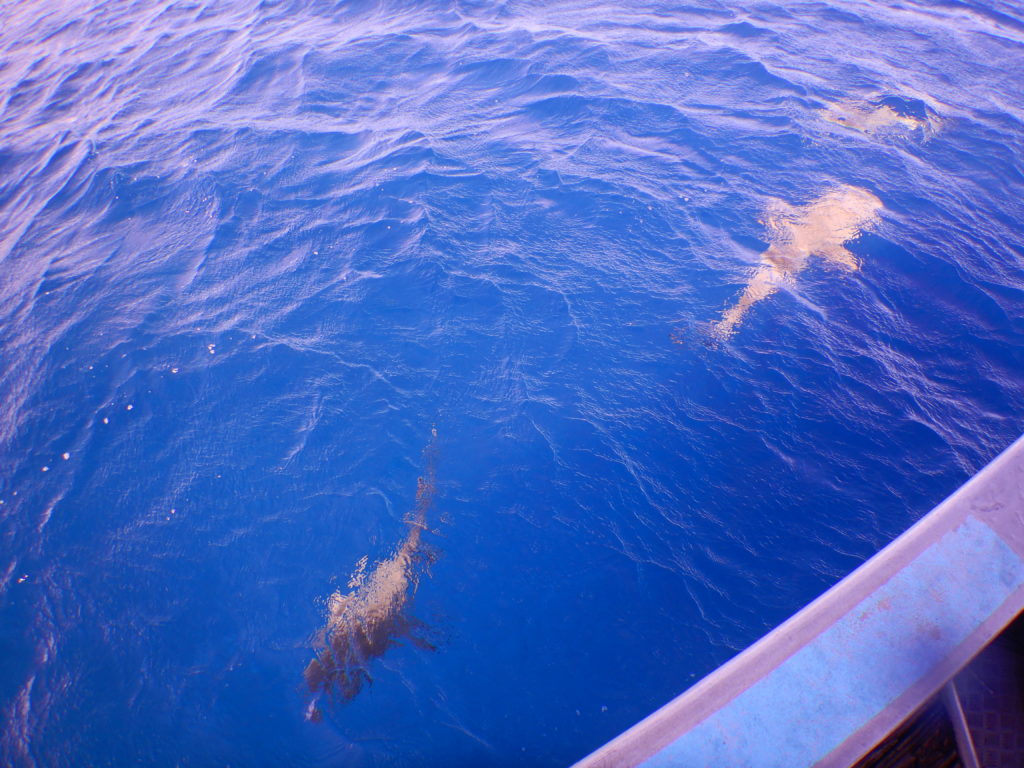
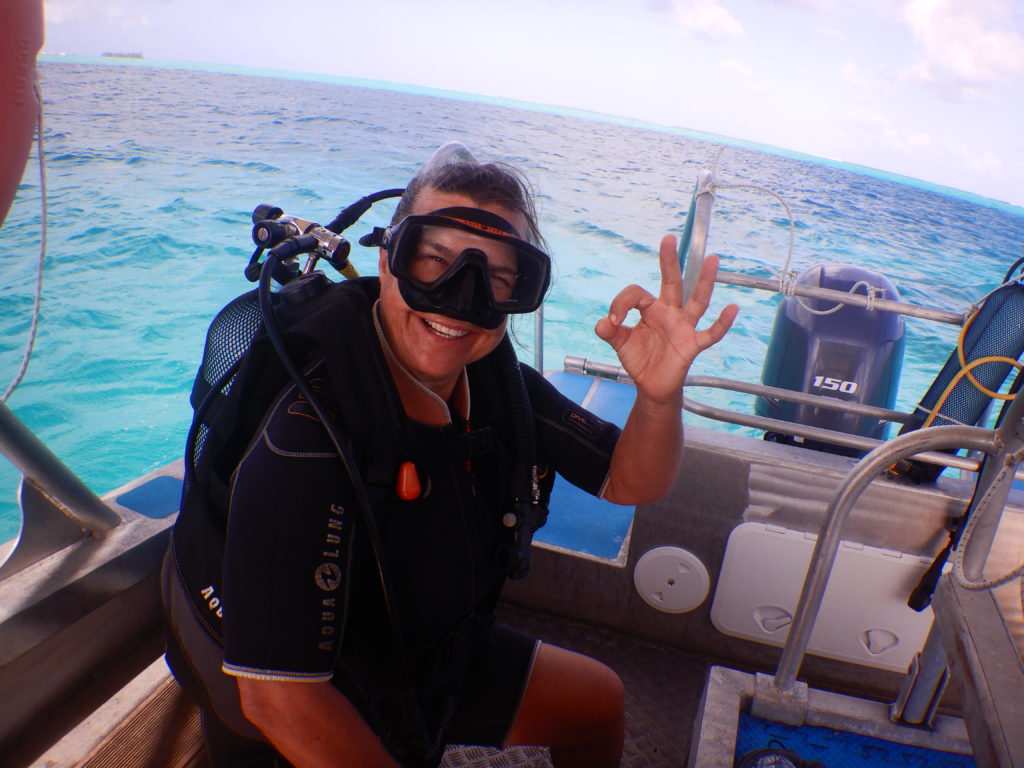
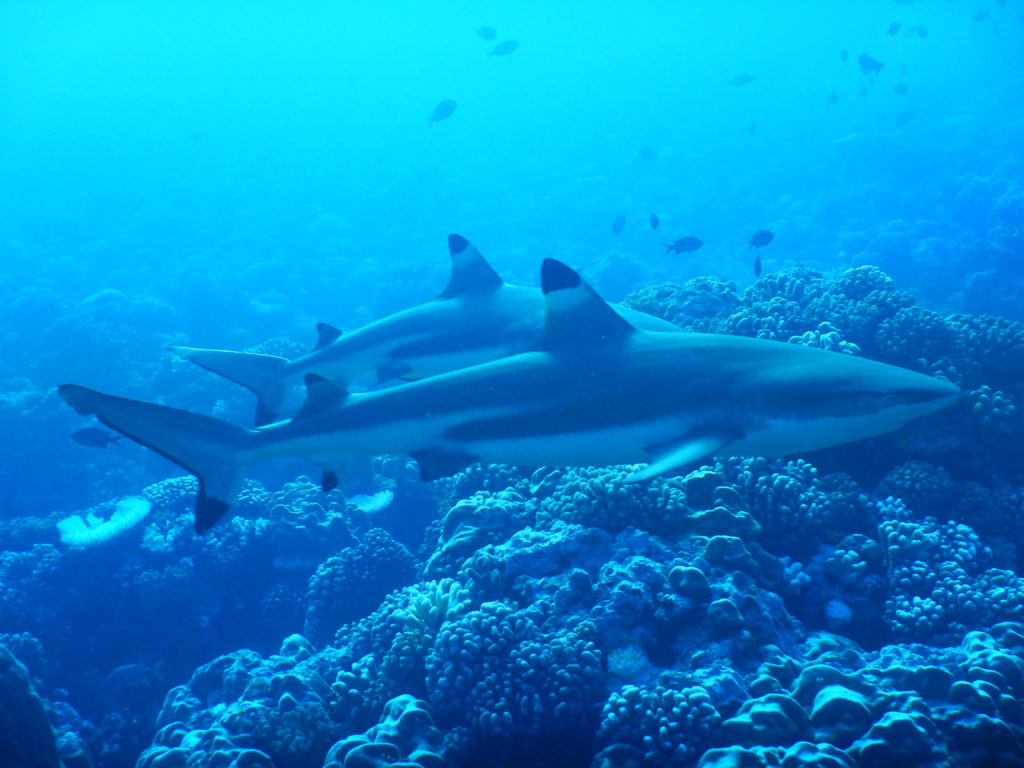
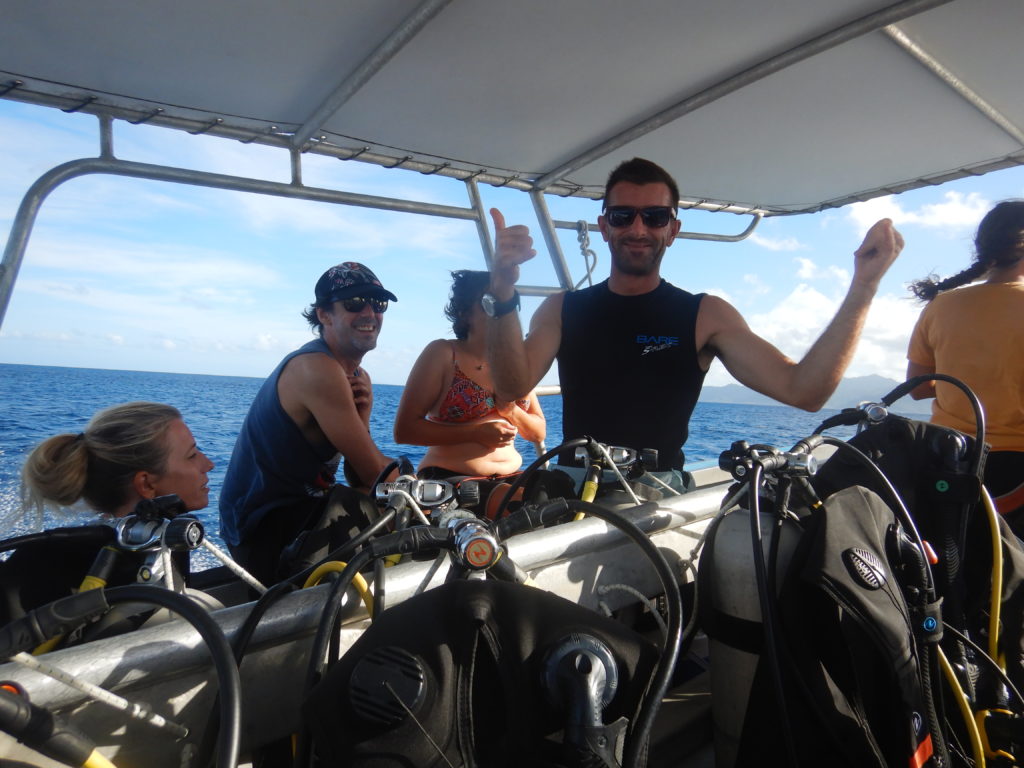
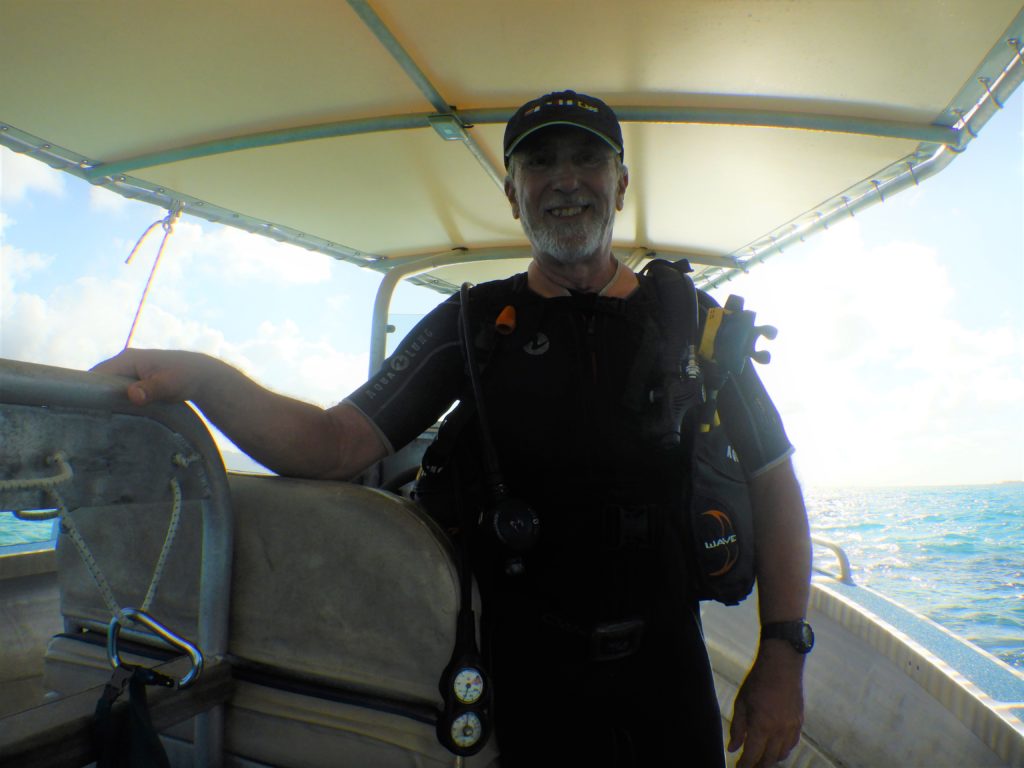
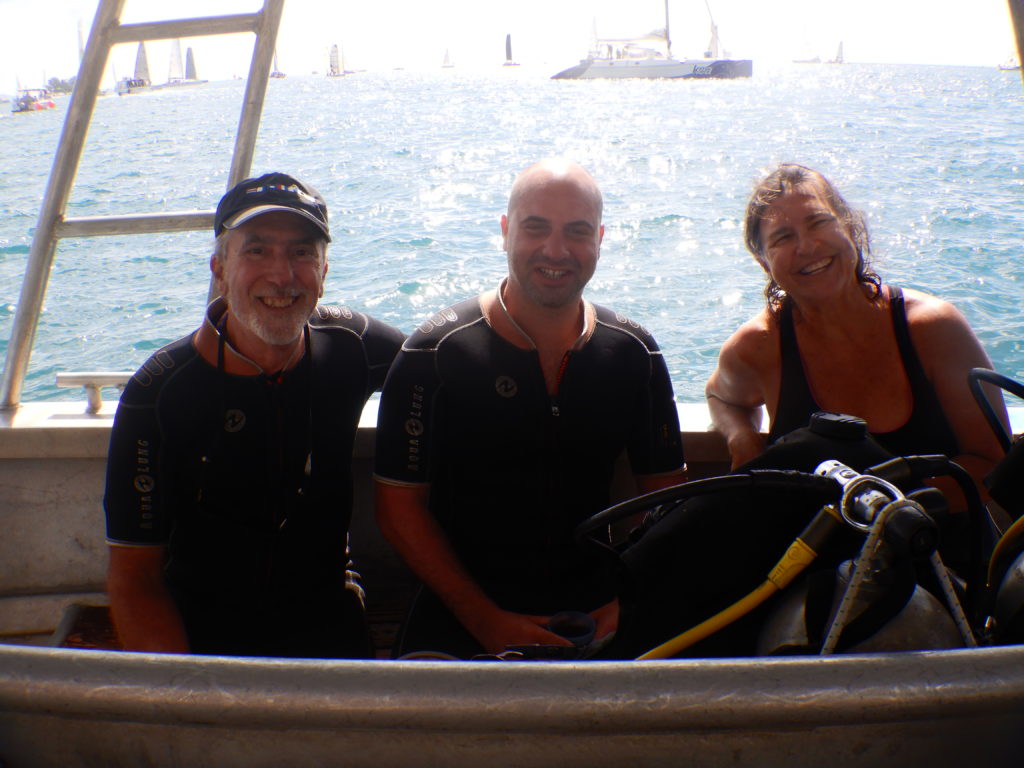
I must admit that deep down in the recesses of my mind rests a modicum of fear of the unknown in the ocean’s depths. I have now been around enough harmless, black-tip reef sharks to not fear them much anymore, although I still am concerned about the potential for equipment malfunction. But you learn quickly to keep such fear at bay while diving. Fear and panic are the diver’s worst enemies; they can kill even when the circumstances are clearly survivable otherwise. Rushing too fast to the surface and getting decompression sickness because you run out of air even though your buddy with extra air and an extra breathing apparatus is close by, is a perfect example of how panic can kill. A fellow diver on a different dive in our same dive boat told me on the motor back to the dive center that he had run out of air and the dive master had shared his air with him rather than ending the dive early. The fellow diver had not had a good dive: first, he didn’t have enough weights on so he was working too hard to stay down, and then because of all the extra exertion, he ran out of air, and then the dive master didn’t end the dive as would have been normal procedure, all else being equal, but forced him into relying on air that was not his own. But, the diver said, that’s ok, because he appreciated the opportunity for diving to once again teach him the importance of remaining calm: a good lesson for life, even apart from the dive. So diving even has a spiritual component. Who knew?
ISLAND HOPPING: RAIATEA TO HUAHINE AND BACK
All of our island visiting, activities, social gatherings and epiphanies seem to blend together as if at random unless I provide some chronology to the picture, so here goes, more or less, in the order in which they happened since our last blog post: we sailed from Raiatea to Huahine, a little over 20 miles SE of Raiatea, not long after the last blog post, where we stayed for a week or so. Well, we didn’t actually sail, we motored. That direction is right into the prevailing wind, currents and swell, so the best we could hope for was calm seas and little resistance to motor against.
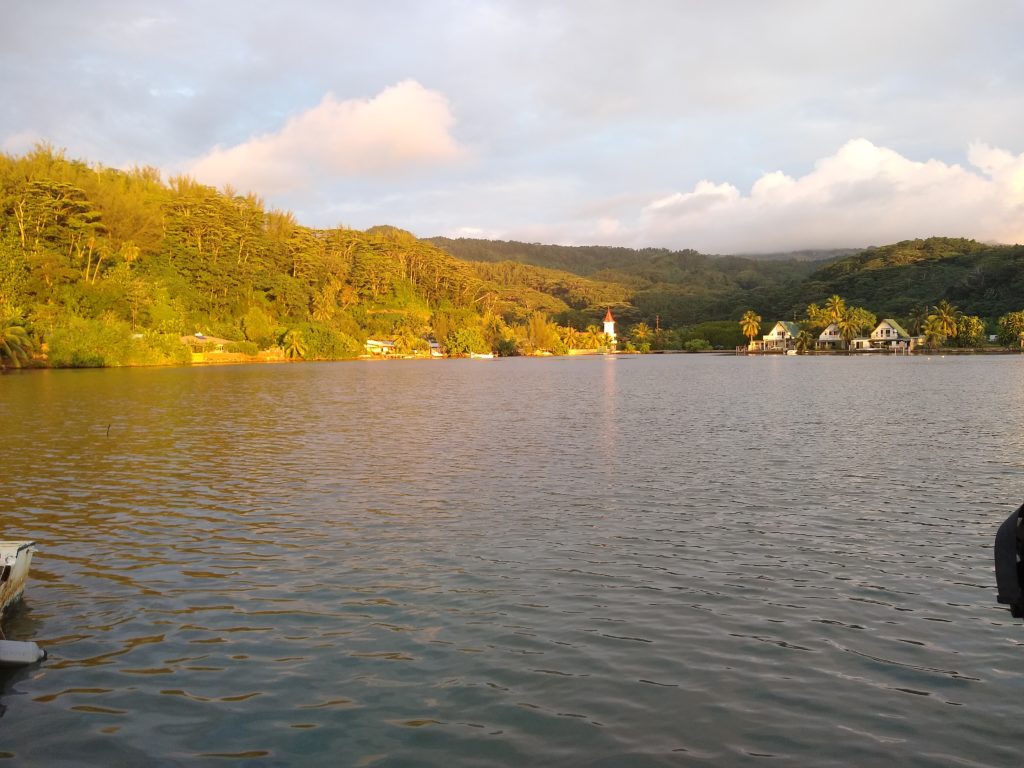
Huahine has been my personal favorite of the Society Islands. It has a little over 6,000 people scattered over two islands within the same lagoon, Huahine Nui and Huahine Iti. It is almost entirely rural, with the little town of Fare as its biggest urban center, and that only has two main stretches of road that each have businesses for only about two or three blocks. Even so, the grocery store there is better stocked than anywhere else I have seen here except maybe in Papeete. We had been there last year as well. I loved our scooter ride around the island last year, and will never forget the lovely paved road all the way around down rolling rural landscapes edged by mountain jungle on one side, overlooking the lagoon on the other side, and how well-manicured everyone’s landscaping looked. The homes were quite modest for the most part, but the gardens were gorgeous. I figure all of those holidays and time off that French Polynesians get are spent devoted to taming the surrounding jungle growth into gorgeous landscaping and food-producing trees, scrubs and plants on their family’s property, which is handed down from generation to generation. All of the colorful indoor plants we have in the US are planted outside here. Lonely Planet calls Huahine, “immaculately tropical.” Good description.
This visit, we had our customary sunset cocktail at the Huahine Yacht Club, dinghied around the main bay near the principal town of Fare at sunset, sailed down to Avea Bay to enjoy the calm anchorage and sunset cocktails at the Mahana Resort, ate at a roullotte near the Mahana, and participated in a day-long tourist boat ride around the island with a bunch of French tourists and one young Mormon couple from Utah. The tourist boat ride was an unusually unauthentic activity for us, but we got to see parts of the lagoon that are inaccessible by sailboat, we learned that the central mountain is in the shape of the sleeping pregnant woman who the island is named after, I learned how to squeeze coconut milk out of coconut pulp, and Rick learned how to shake his knees in a traditional male hula dance!

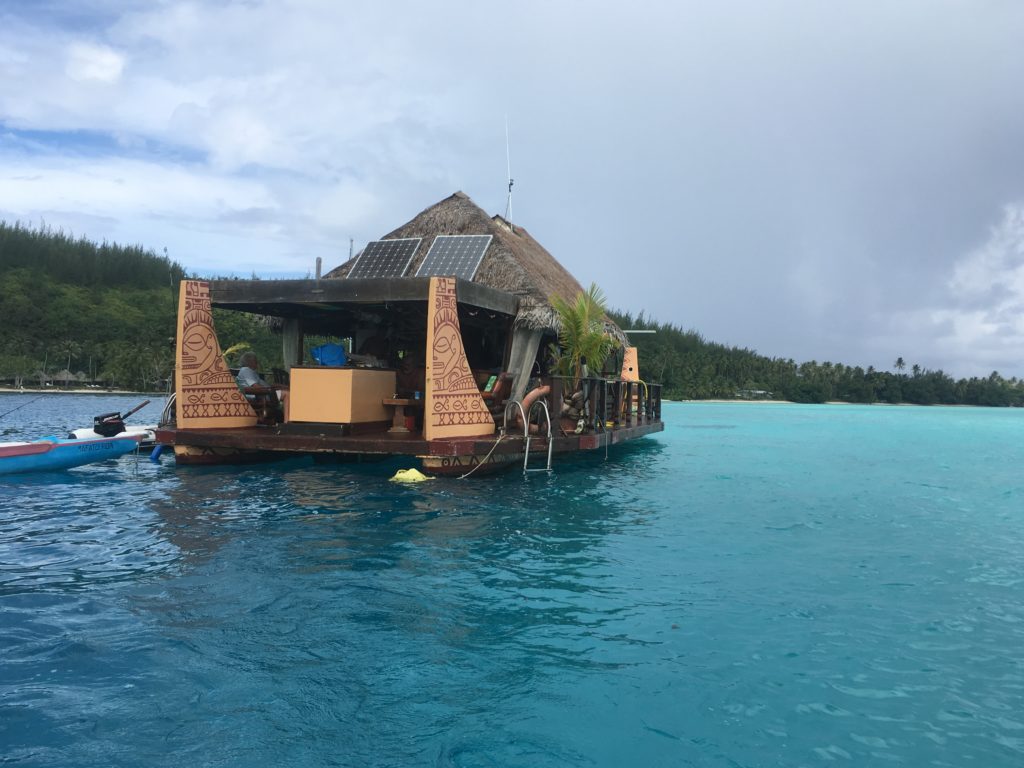
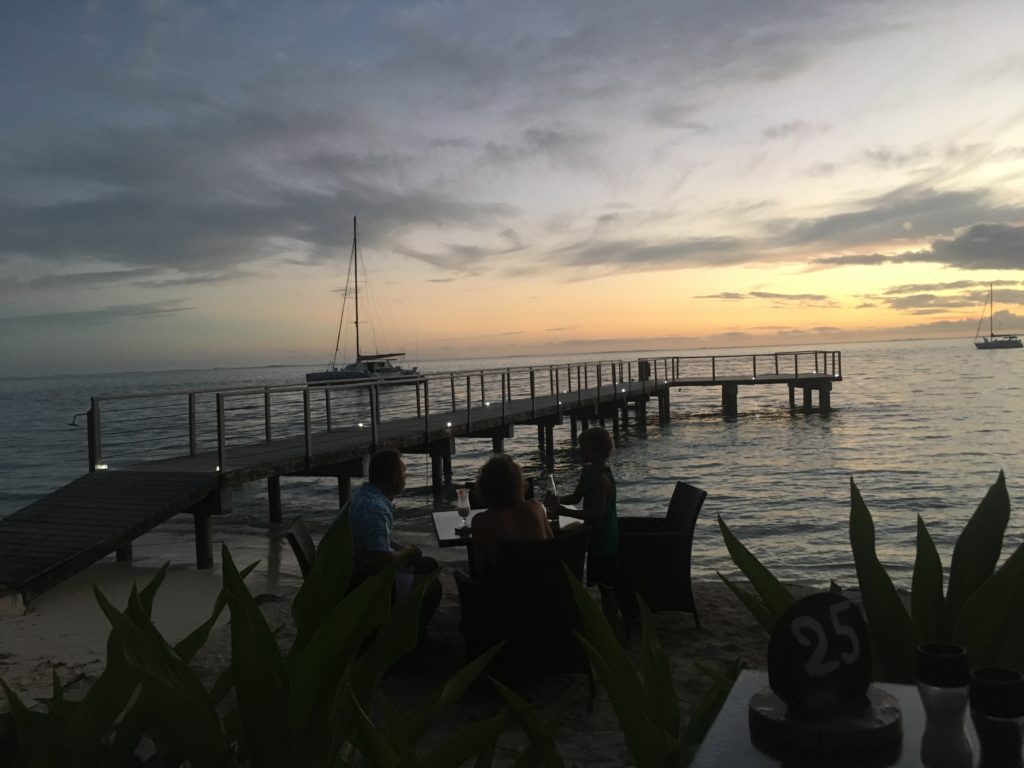
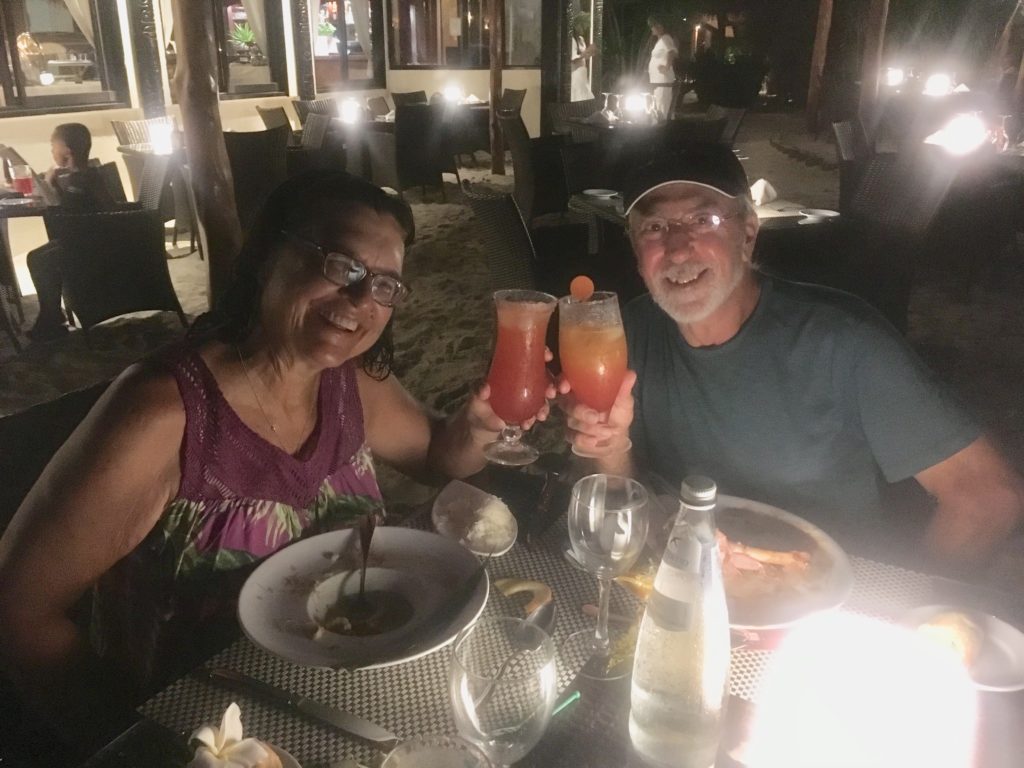
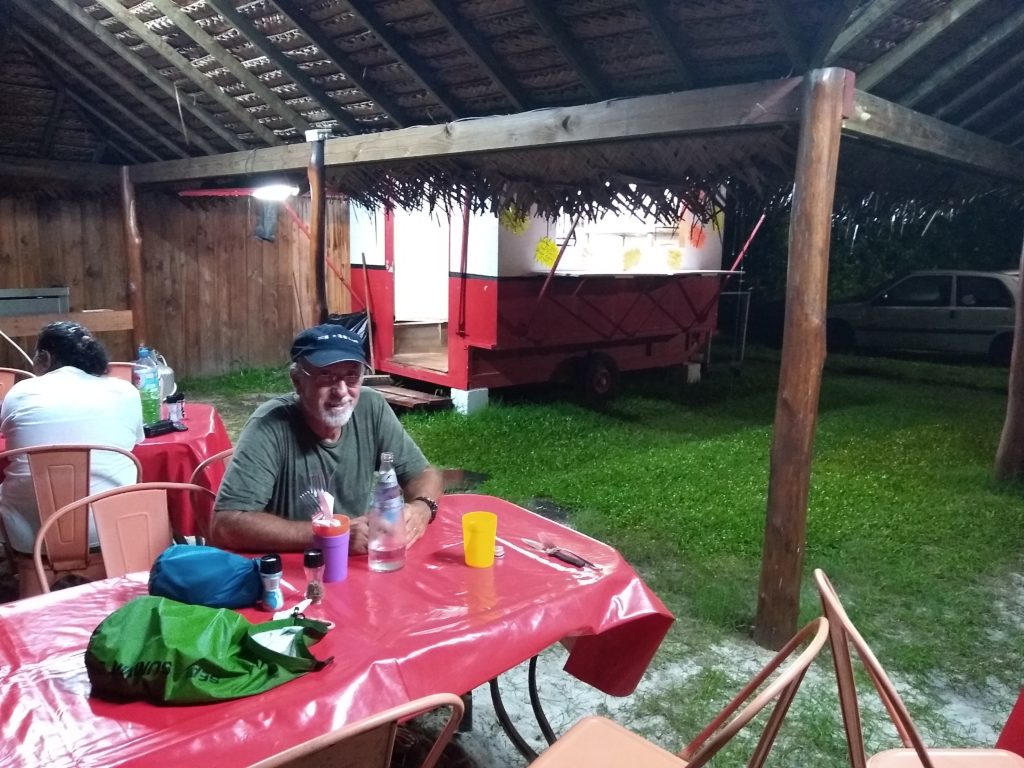
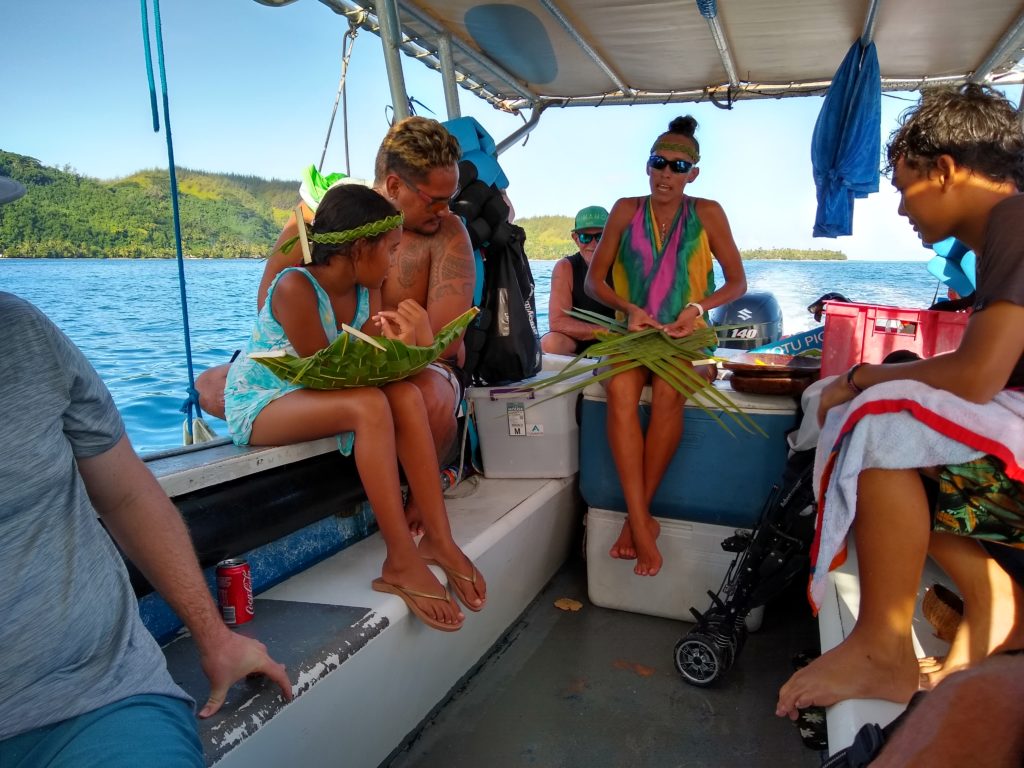
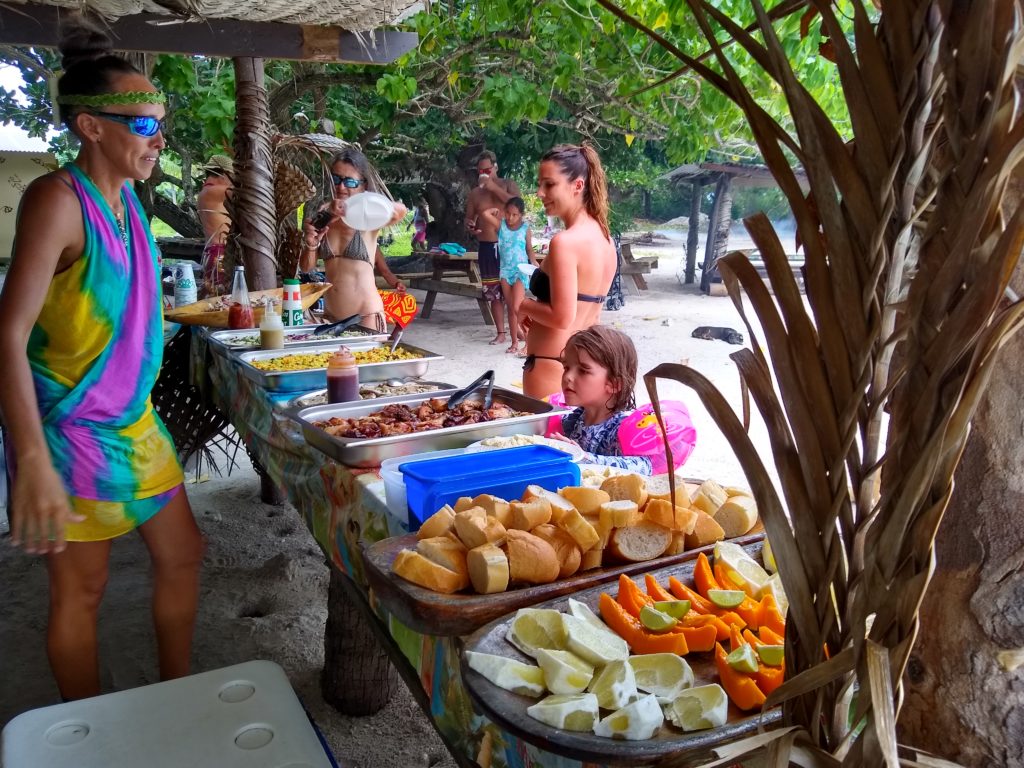
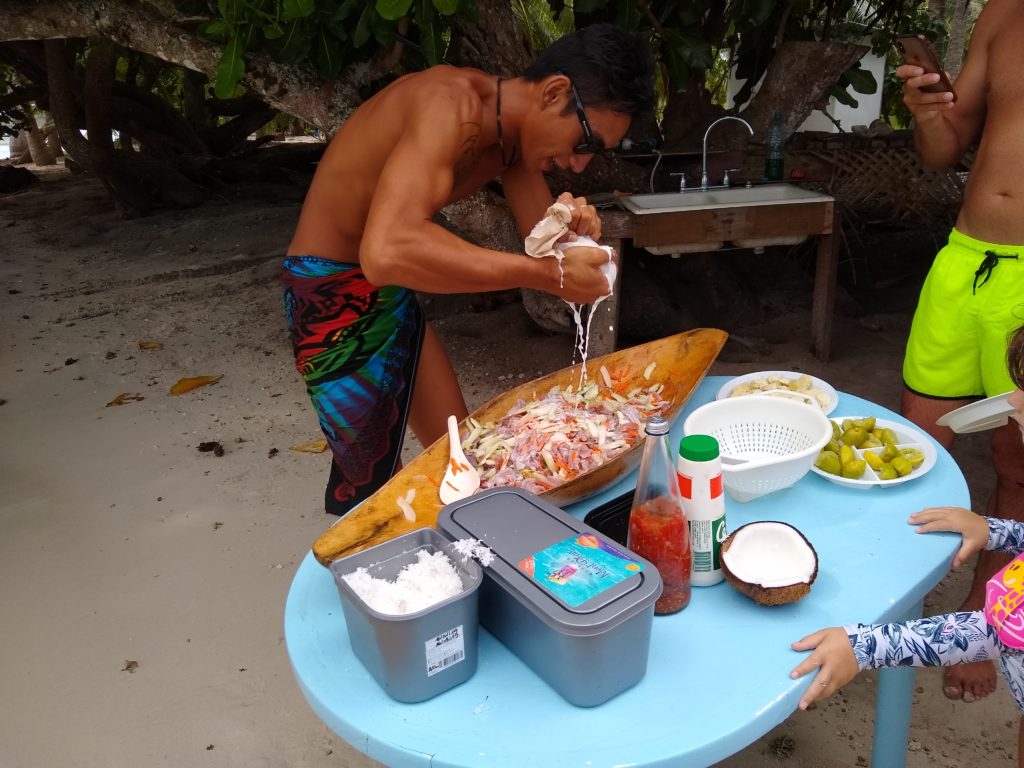
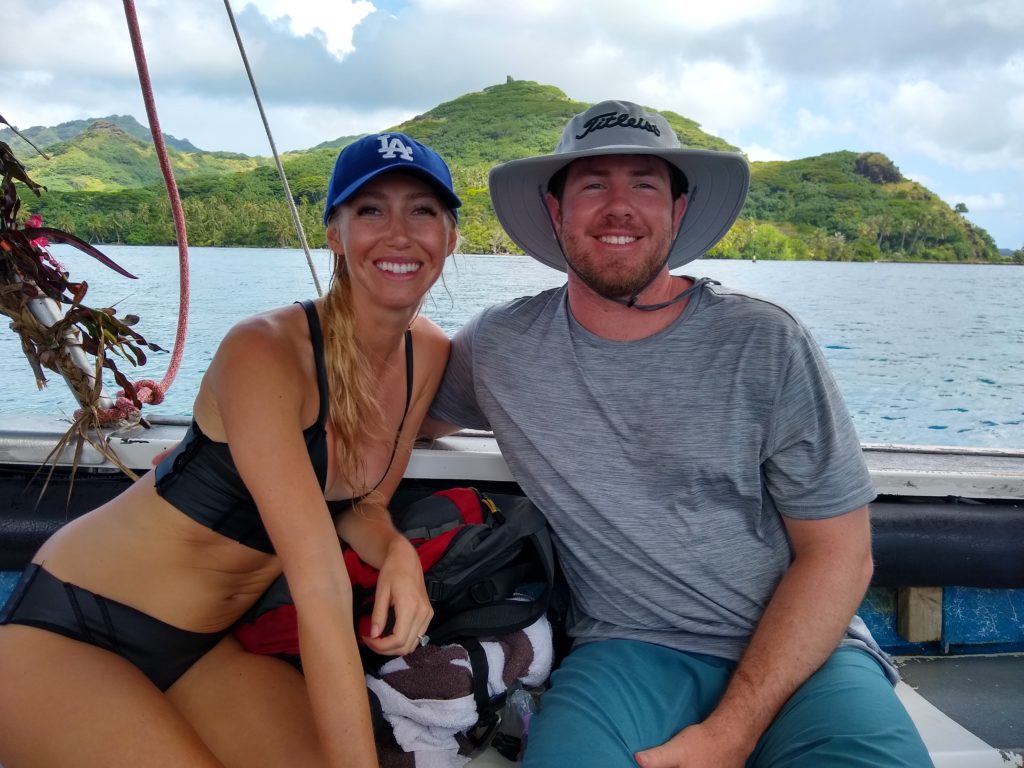
A MINOR MEDICAL EMERGENCY
It was a good visit, but my desire to sail over to the east side of Huahine and anchor for a few days was foiled by a more immediate concern: I managed to contract a urinary tract infection and needed medical attention. Specifically, after having had a UTI in Mexico that had been caused by an antibiotic-resistant bacteria, I needed to have a culture grown in a laboratory to determine what type of bug caused the infection before it could be determined which drug to use to cure it. (I had various antibiotics onboard but I didn’t want to use one that wouldn’t work). And as any woman who has had one knows, UTI’s are agonizing. Your belly feels painfully bloated and you have a desperate desire to pee all the time, but when you do try, it burns like heck. The sooner I could get diagnosed and treated, the happier I would be.
Of course, there is no laboratory on Huahine, so we sailed back to the administrative capital of the leeward islands, Raiatea, at the first opportunity after I realized I was sick. We came into the Uturoa town dock on Raiatea at mid-afternoon on a blustery day, only to find the dock full except for a precarious outer cement wharf where the security guards told us we could not spend the night. We tied up briefly, I explained to the security guards that I needed to go to the hospital, and I rushed off. But when I got to the hospital, I discovered that the lab was closed in the afternoons, but even if it were open, I couldn’t give a sample for a culture anyway unless I had a doctor’s order, so I needed a doctor’s appointment and none were available that day. (In retrospect, I probably should have gone to the emergency room but I couldn’t find it!). Anyway, from the hospital I walked downtown in search of a doctor, any doctor, who could order a lab test for me. I found one, but he wouldn’t be available till late in the afternoon. Doctor’s order in hand, I rushed back to Cool Change so we could get underway before dark. Fortunately, we had previous tracks on our chartplotter that lead us in the dark to the Apooiti marina around another side of the island, and we managed to find an outlying mooring and grab it in the dark in spite of discovering we hadn’t charged our spotlight.
The next day I hitchhiked early in the morning to the hospital laboratory, lab order in hand, only to find a mob of people ahead of me. I took a number and left three hours later, just as they were closing. I was told to return the next day at 2 pm for the results, but they were closed at 2 pm, and had been closed since noon. I am not sure why I was told that! My doctor didn’t have the results either, so I had to wait over the weekend until Monday to get the results, six agonizing days from when I discovered the infection.
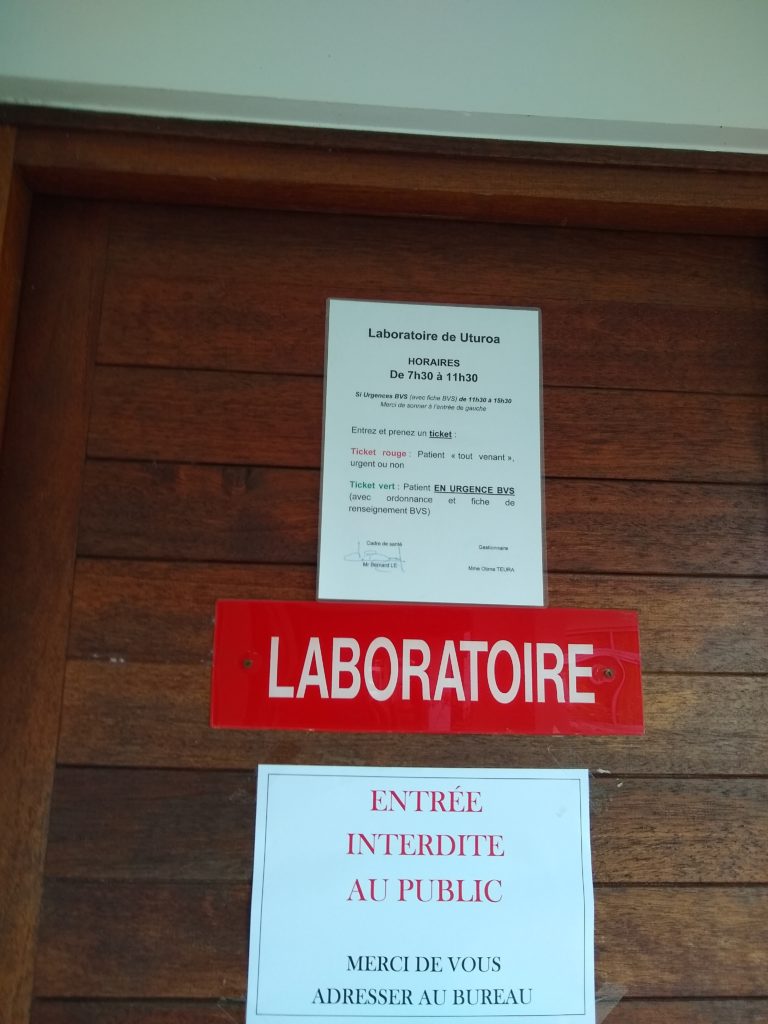
Well, not all medical experiences in foreign countries are bound to be as favorable as what I experienced in Mexico or even in Tahiti, and this one was a little frustrating, but in the end I got what I needed. I had two doctor appointments, a lab test and medication, all out of pocket for about $150 US.
MORE BOAT MAINTENANCE AND SOCIALIZING
Meanwhile, we were able to slip into the guest dock at Marina Apooiti, which is available only on a first-come, first-served basis. Knowing that I would have to go back to town for all this medical stuff several times, we knew it would be most convenient if we were at the dock. Once the medical visits were done, we thought, well, let’s take advantage of the electricity and fresh water connections at the dock to do some boat cleaning, maintenance and laundry. Good thing we did do some maintenance, by the way: Rick suspected the control line for the windvane might be wearing, and when we took it out of the tubing, we found a section that was threadbare and ready to snap! Besides, we wanted to stay at the marina because it was a safe location for the inclement weather and big winds that were brewing. We also get more glimpses of island life when we are tied up to land.
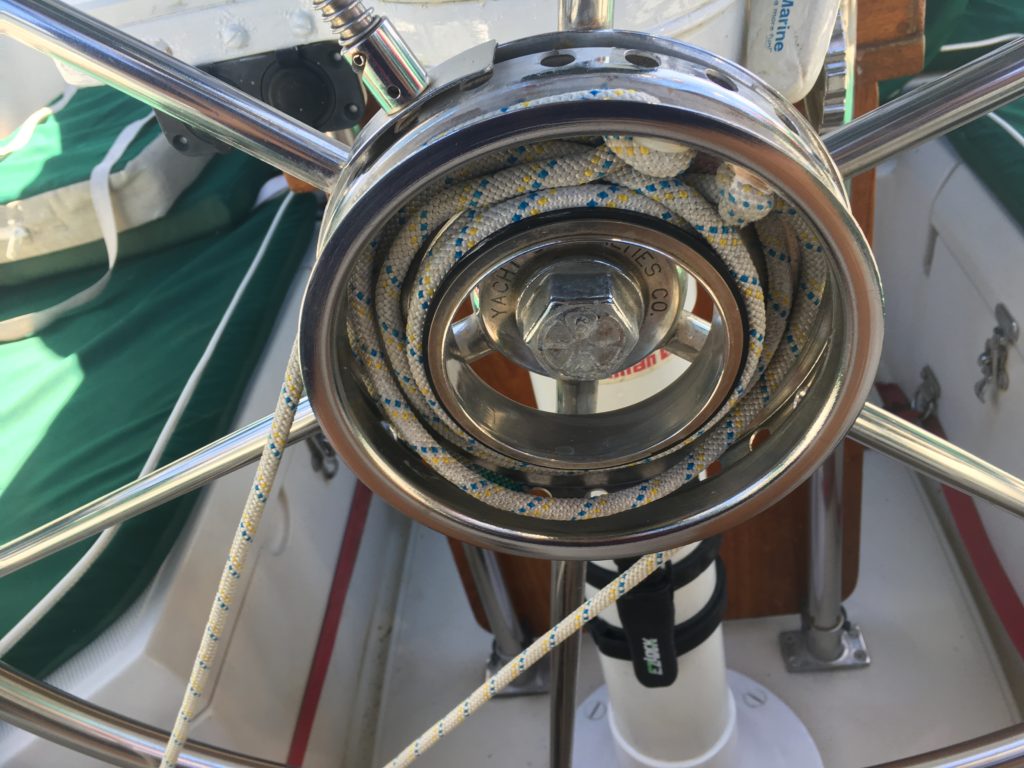
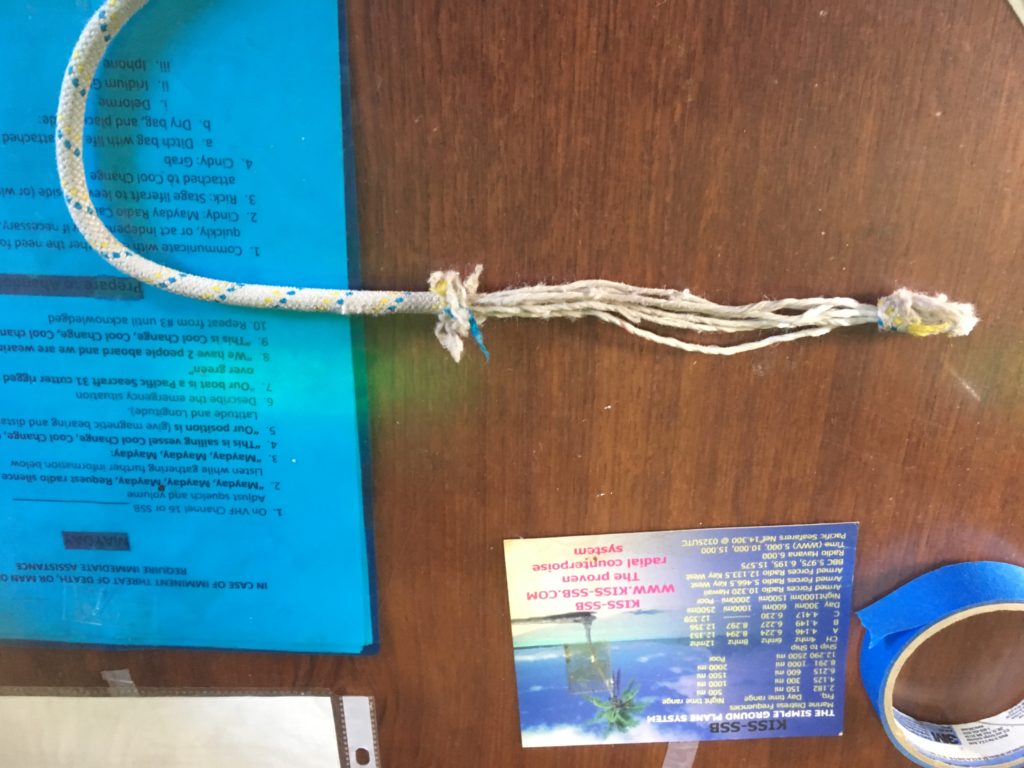

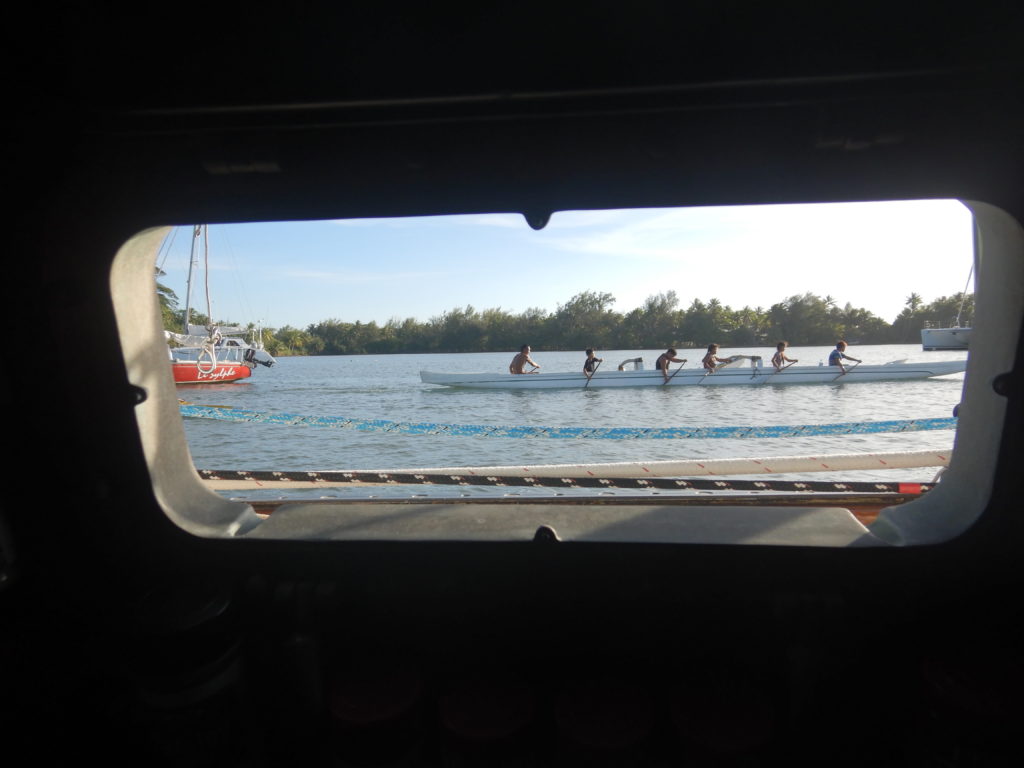
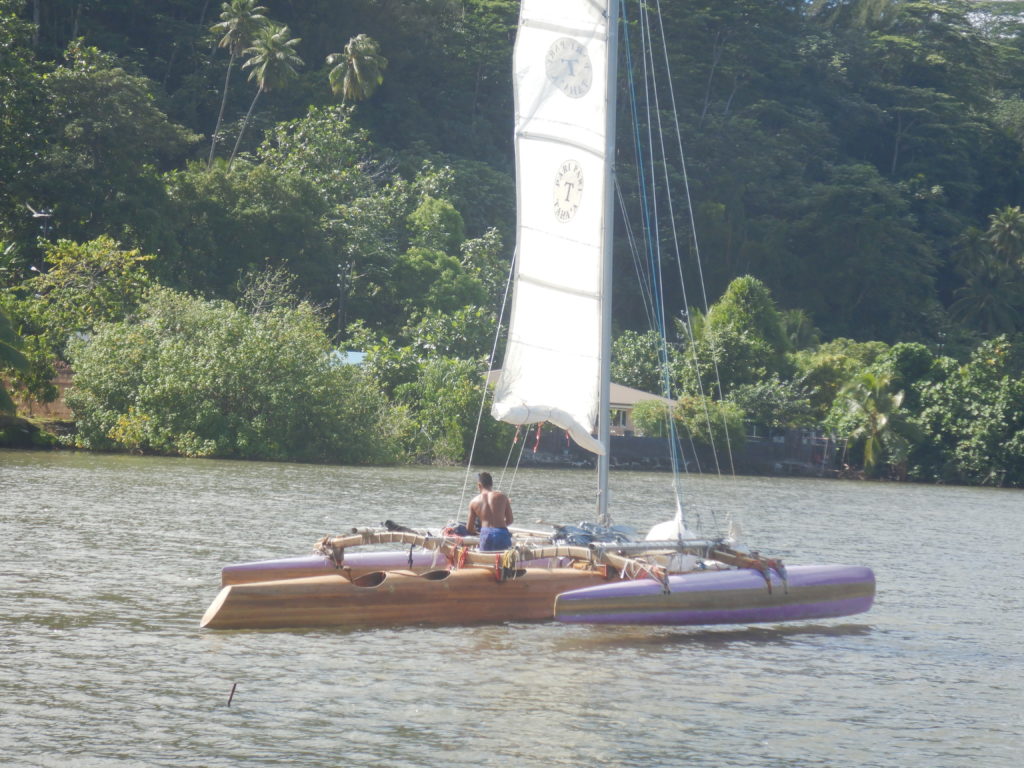
And then it occurred to us, you know, the dive center is right here next to the guest dock – as soon as the weather improves, why don’t we get our dive certifications while we are here too? As it turned out, the dive certifications required internet access for online studying that was supplied by the dive center, so we needed to be there every day for studying until we completed the course. Meanwhile, Rob and Nancy from Shindig arrived from the US to recommission their boat and bring us some goodies we had forgotten, so we began enjoying more time with them. They rented a car for the week and I was able to catch a ride with Nancy to town for provisioning several times. We visited with Mike and Kelly on the boat Dash, a beautiful 56 foot Taswell, who sailed to French Polynesia last year with the same group we did and were on an Apooiti mooring ball. And then just as we were about to leave, we were invited to the birthday dinner for Rob, and it was easier to get to the restaurant from the Apooiti dock, so we stayed yet a few days longer.
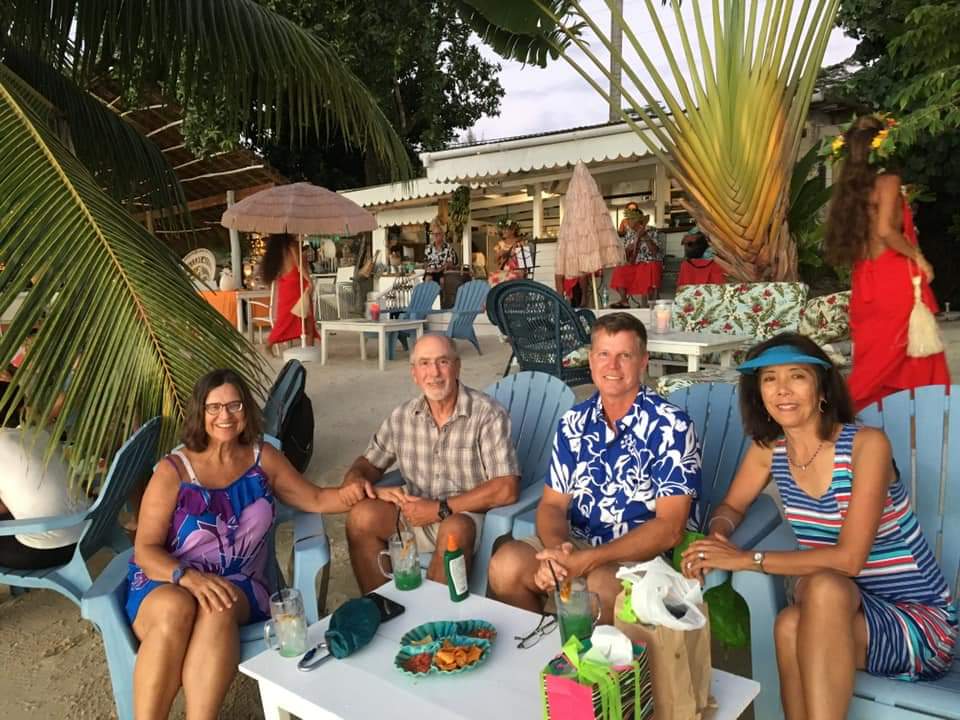
All told, we stayed at the Apooiti guest dock a little over three weeks. The guest dock is not cheap, so that little stay ate up all the savings we so proudly accrued in the last few weeks of anchoring out free of charge. And by the time we left, we were so ready to get out onto a peaceful anchorage along a remote reef again. It is convenient to be tied to a dock, but it is hotter with little breeze except in a big blow, the bugs at sunset make it difficult to enjoy the cooler evenings outside, the arguments of the couple in the boat nearby are disturbing, and the shore parties and drumming often make noise well into the morning hours.
MORE ISLAND HOPPING: RAIATEA TO TAHA’A TO BORA BORA AND BACK
So off we went as soon as we were able, back to our favorite anchorage along the reef on the east side of Taha’a. But for fun, we took the long way around to get there. We hadn’t sailed for so long that we decided to sail 3/4ths around Taha’a instead of motoring the other 1/4 in the opposite direction to get to our anchoring spot. It was a fun day sail inside the lagoon, where the swell is nonexistent and the wind chop is minimal. We got to sail on every point of sail, which was good practice for us, after sailing downwind almost all of the time. We poled out and sailed wing-on-wing, and tacked and jibed and everything in between. A good first day sailing after a three week hiatus.
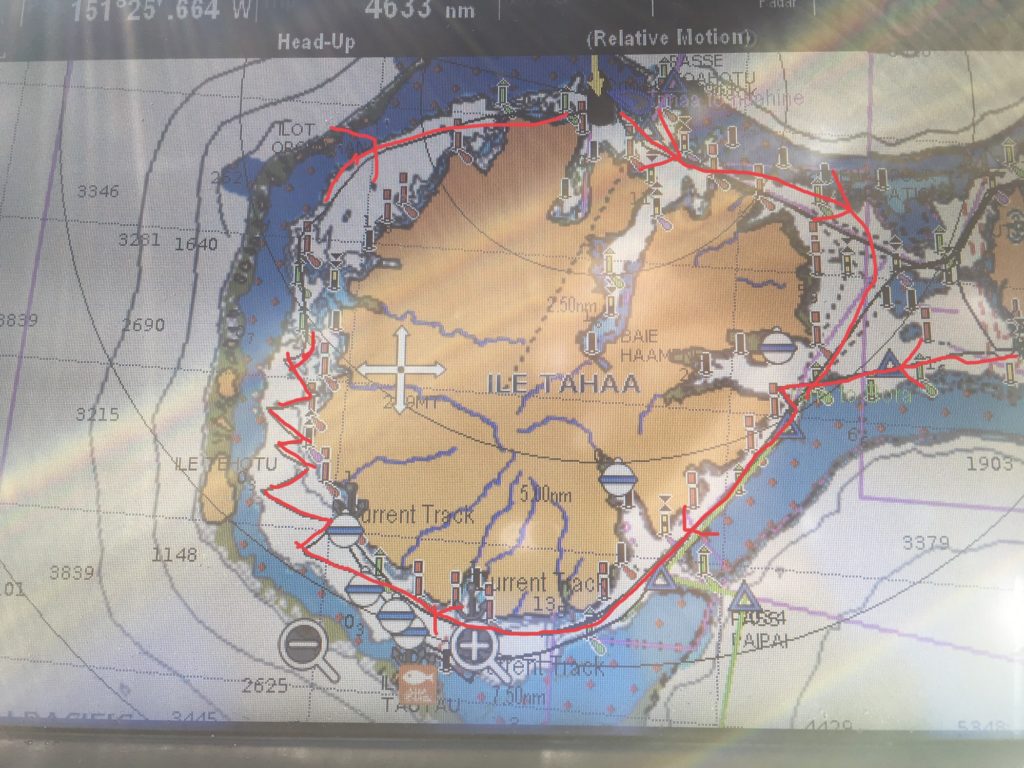
Taha’a is starting to rival Huahine as my favorite island. For one thing, it is the only island in the country where you can sail all the way around the island inside the barrier reef. That is so cool. I really don’t know much about the island itself, as we have only gone ashore in a few select places, but I like that it defers to it’s close neighbor within the same lagoon, Raiatea, for most of it’s business and shipping concerns, leaving Taha’a to be mostly rural and residential. We need to rent scooters there too, so I can make my final judgement on my favorite Society island!
But what the heck, we had some time to kill before our expected deliveries of equipment would arrive in Raiatea. Why not catch a breeze to Bora Bora? I knew Rick had been itching to get back there. From Raiatea and Taha’a, the Bora Bora silhouette calls to you like sirens from the deep. You can almost hear the song “Bali Hai” in the background.
So off we went. We had a very nice downwind sail and smooth seas for the 20 miles or so between islands. We took one of the last moorings at the Bora Bora Yacht Club. Many new moorings had been added there since last year, and they were almost all occupied. The French Polynesia Cruiser’s Facebook Group included a number of postings about how the mooring and anchoring situation in Bora had changed since last year; something about how they were installing all kinds of new moorings around the island, they were going to centralize the fee collection system under one municipal agency, and that anchoring was going to be prohibited, etc. It was all very scary stuff, to think we could no longer anchor for free in Bora. We were also told by a fellow cruiser who had just been there that the new plan was going into effect May 1, 2019, but that the Bora Bora Yacht Club moorings were excluded from the municipal fee collection. Instead, the Yacht Club would collect from you only if you used their dock.
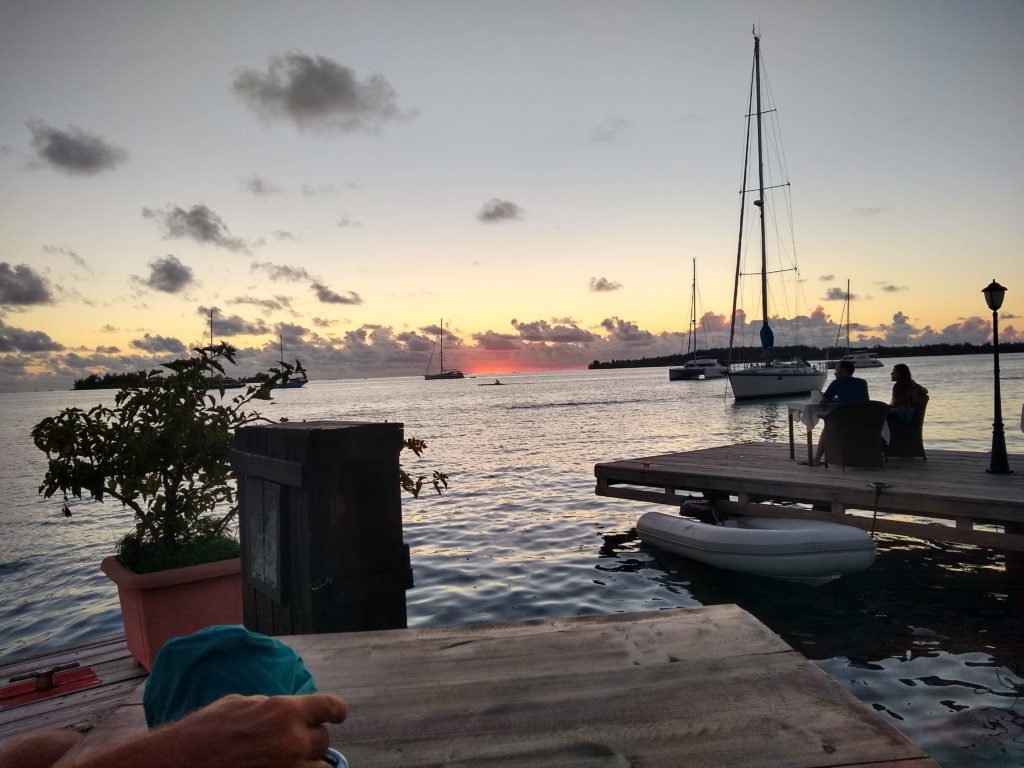
Well, the truth by the time we arrived was a little different. The Yacht Club’s moorings were excluded from the municipal collection system but only until the ARC Around the World Rally participants had come and left. (This is a cruisers rally that lasts 15 months, and starts and ends in the Caribbean). We arrived while the ARC boats were there. That is why there were so many boats in the mooring field. However, some had already departed for their next leg. So, we got a mooring for free for a couple of days. We did some provisioning in town, and decided to take advantage of being at a mooring near town to rent some scooters and circumnavigate the island. Rick had at some point proclaimed that Bora was his favorite of the islands, but we really hadn’t seen most of it except from the water.
Our self-guided, around the island scooter tour was interesting. It was only 20 kilometers around – Bora is the oldest of the Society Islands and has started to sink back into the ocean like its neighbors in the Tuamotu archipelago, so the center island itself is smaller – but we managed to make a whole day of it anyway. We stopped at a nice little outdoor cafe associated with the Mai Tai resort on the lagoon so I could have an umbrella drink, and we rode our scooters out into some residential neighborhoods on a few small points. We tried to ride up to a lookout on the mountain but we dead-ended onto private property; apparently Bora hasn’t decided that such a lookout is a tourist priority like so many of the other islands have. We stopped at the gorgeous public beach at Matira and got a better perspective on what we had heretofore only seen from the water.
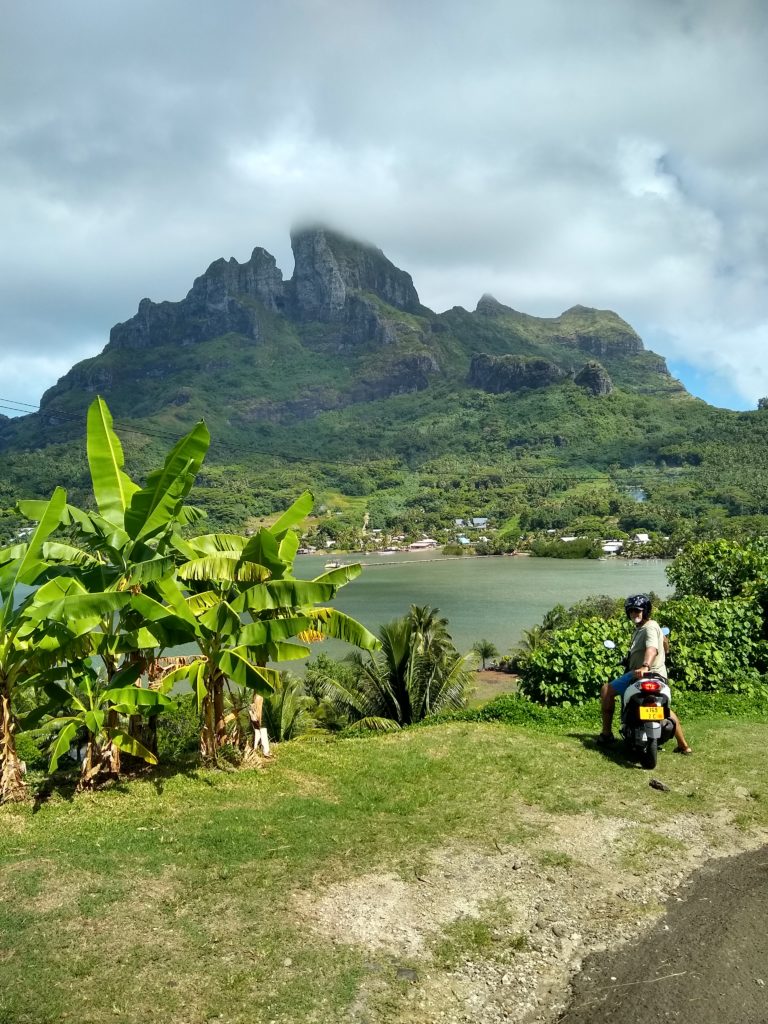
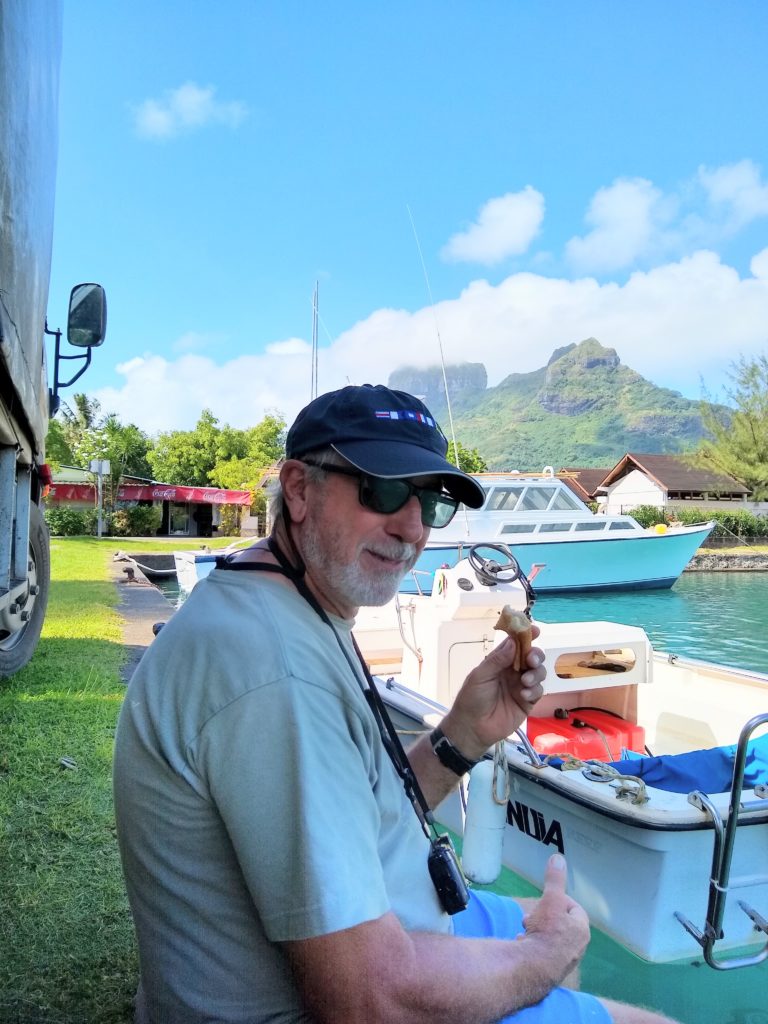
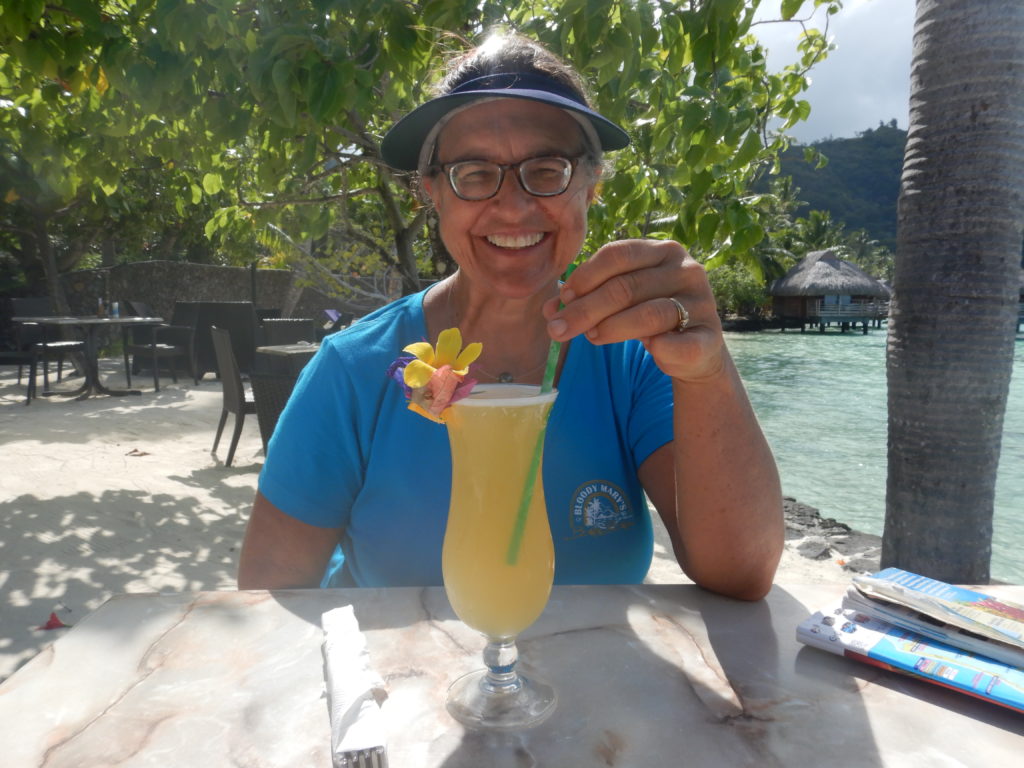

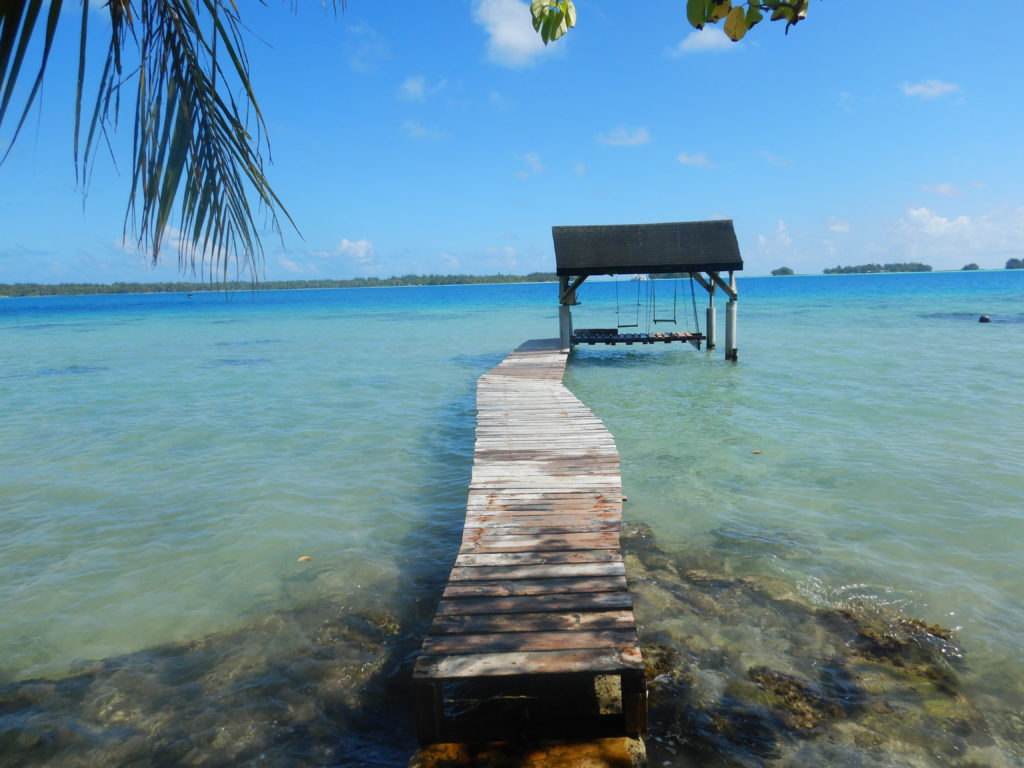
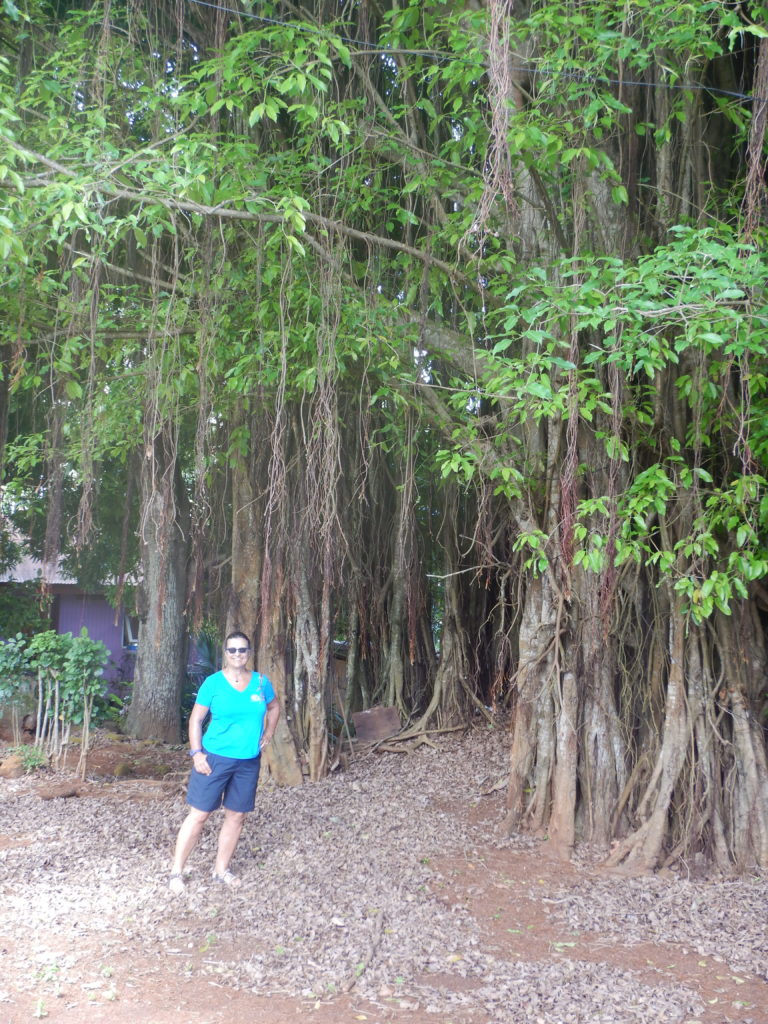
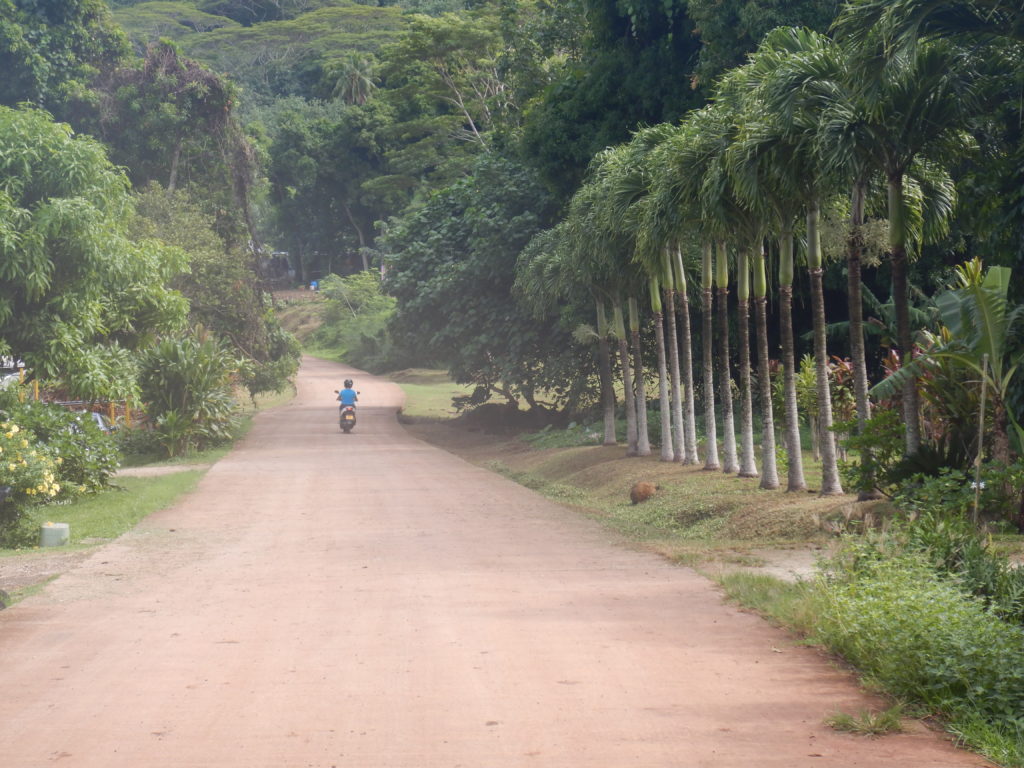

Nevertheless, we were a little disappointed by our scooter ride, actually. Most of the fancy hotels for tourists are on motus surrounding the island of Bora Bora. In fact, many of the resorts on the island itself have closed down. That is something we have never liked about Bora. On other islands, cruisers like ourselves are welcomed to the island resorts as additional income, but on Bora, the motu resorts are exclusive and discourage visitors. The island of Bora itself has become relegated to just the workers of the hotels and not the hotels themselves. And the people living here don’t seem to take as much pride in their homes as they do, say, in Huahine. With a few exceptions, we didn’t see well manicured landscaping or beautiful plants or many crops of any kind. The island is totally and completely devoted to the service of tourists on the motu resorts, and it seems that a loss of pride, and maybe heritage, has accompanied that change. For one thing, they have shifts seven days per week due to the resorts, unlike most of the rest of the South Pacific Islands. Or maybe the downfall started much earlier, when 6,000 American troups arrived here all at once during World War II and bulldozed their way around the island perimeter to build a road, as well as building an airport. Within a span of a few short years, Bora Bora, previously called Pora Pora, was transformed from a sleepy, remote island of primitive means to a bustling international military installation. It is such a shame that the culture has lost most of its authentic charm, because the geography of the expansive lagoon and the silhouette of the mountains in the middle are absolutely stunningly beautiful.

Even if the island culture itself lacks character, Bora still has some magnificent mooring/anchoring locations in the gorgeous lagoon. We are now sitting on one of the very new, very well anchored mooring balls on the far side of Bora. We like it over here because it is far from the principal bay on the other side of the island and there is almost no boat traffic. The water is light blue and the snorkeling over here is fantastic. We are still in the midst of a weather event – it has been raining every day for the morning, clears up a little in the afternoon, and then more rain at night. Today the wind has picked up a lot too. We haven’t gone out for dinner to celebrate our anniversary yet, and we will need to provision soon, so I think we will be heading back to the busier side of the lagoon within the next couple of days. Most of our deliveries have now arrived in Raiatea, so we need to get back there to pick them up, but it looks like we won’t have cooperative weather for that upwind, against the swell sail until maybe next week. Meanwhile, we are relaxing in this lagoon, checking email and making phone calls with WhatsApp on our GoogleFi phones to the US for free, and staying in touch with our loved ones back home.
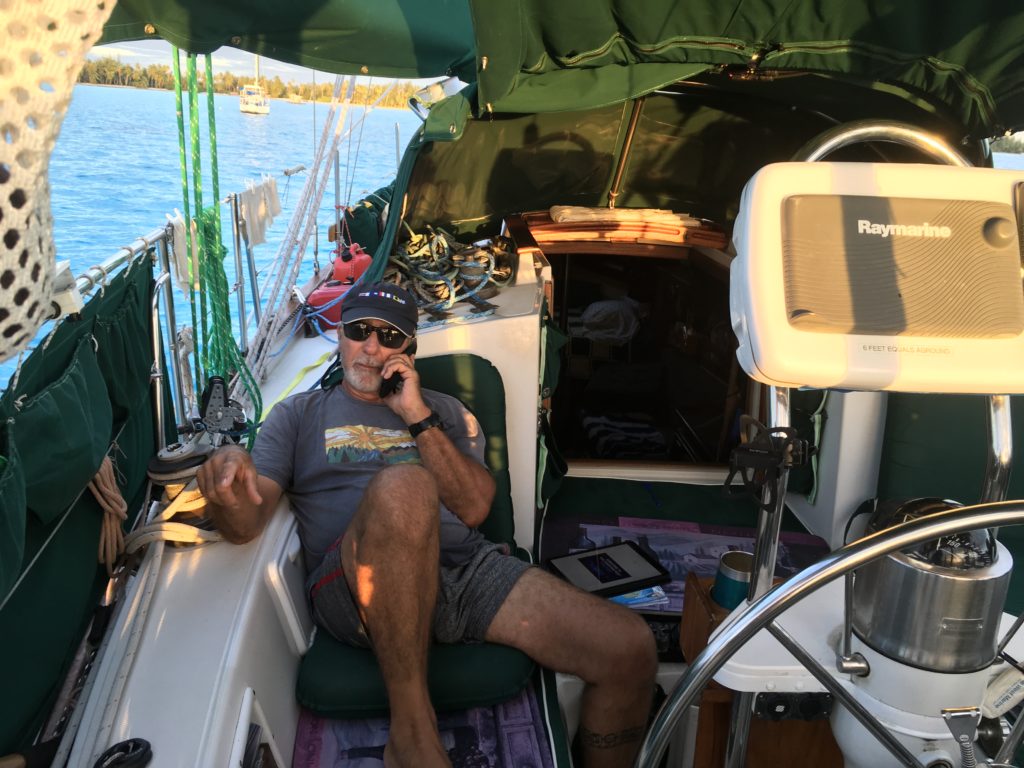

As an update to my previous post, I should mention that our eating habits have been deteriorating somewhat, I am sad to say. Yesterday I made pasta with chicken, sun dried tomatoes, kalamata olives, artichokes and pesto, most ingredients having been packaged with a substantial amount of olive oil – not the healthiest or lowest calorie meal, by any means! But my attempt at focusing on fresh tuna backfired with both of us getting sick to our stomachs from all the raw fish. We were so disappointed to discover this because I was getting really good at making an awesome Poisson Cru, amongst other tuna dishes such as lightly seared tuna in a variety of sauces. And it felt so good to eat so light. If only we could freeze the tuna first, we could kill parasites and bacteria, but we don’t have a freezer and they don’t sell it frozen. And I looked it up – lime does not kill worms or parasites. So, our choices have been more limited, although we are doing our best.
Well, Shindig is coming over to our boat for sundowners soon and I have to clean! Will continue later ….
A few days later …
TO GO WEST OR NOT TO GO WEST?
(The remainder of this post is just a bit of mental gymnastics, a sort of stream-of-consciousness analysis of our ongoing struggle to make a decision regarding our immediate future plans. Read further only if that sort of process interests you.)
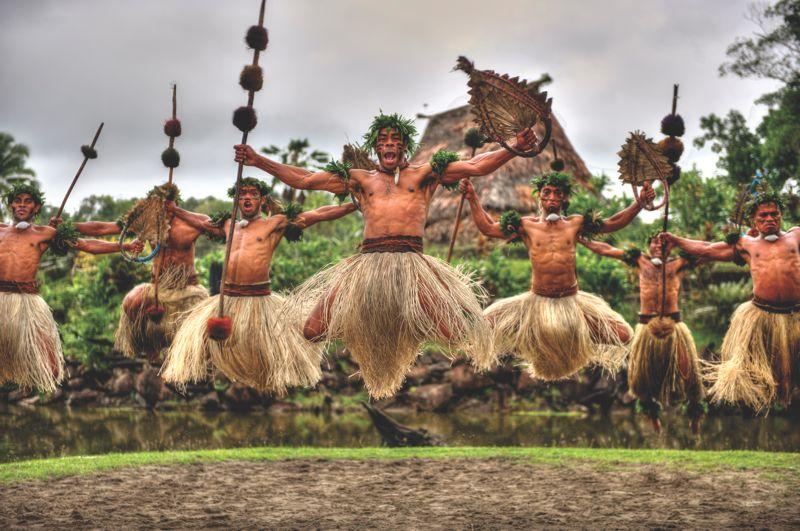
One of the topics I left dangling in our last post was whether we are going to head west towards Australia this year or just remain in French Polynesia and ship Cool Change back to Mexico from here at the end of this season. It has been a tortuous decision-making process, and we both have been all over the map on it. I am not sure if my actions helped clarify the issues or confound them more, but I even set forth the dilemma to my sisters and a few close friends, and also to a Facebook group called Women Who Sail, made up of over 16,000 members. As you can imagine, the responses ran the spectrum from an enthusiastic “go for it!” to an unapologetic “stay put.” But some of the commentary did help to bring the process further along. Had we had less time to think about it and had a deadline of making our decision by a particular day, our decision would have varied completely depending on how we were feeling that specific day. But as it was, we have been waiting for a number of deliveries to arrive, and that postponed the urgency substantially. Meanwhile, we have been weighing the options over and over again, hoping for some epiphany that will shed light on the best course of action.
I have to admit that part of our struggle lies with the fact that our decision-making process as a couple is so interdependent, and we rely so much on each other’s input as part of a team, that both of us have a difficult time sometimes deciding independently what it is we each really want, especially for choices that will dramatically affect the other. Neither of us wants to make the decision that forces the other to come to a conclusion they might not have reached on their own. So I needed to step back and examine each of our independent contributions to the process. What is it I want?
It has been such a circuitous path that I hardly recall where we started, but this is how I remember it. When we were first planning the trip across the Pacific from Mexico to French Polynesia, we knew we were not prepared to circumnavigate the globe. I really just wanted to experience one long ocean crossing. So, we thought we would probably sail as far west as we could, while still having a reasonable point of sail back home via Hawaii and to the northwest of the US. Sailing west anywhere beyond French Polynesia makes the home voyage north and east much less pleasant. Most of our friends who have sailed west past French Polynesia are either planning on circumnavigating, or selling their boat in New Zealand or Australia.
Furthermore, we had always projected that our cruising lifestyle would come to an end after about five years; after all, there is life beyond cruising, and we have a beautiful home waiting for us and family to share our hearts with.
After fulfilling our original goal of crossing the Pacific to French Polynesia, we could then begin to focus more on how we were going to get Cool Change home again. We learned that the sail from French Polynesia to Hawaii could be long and quite uncomfortable. I really wasn’t looking forward to more discomfort – our big crossing had given me enough of that. We didn’t really want anyone else to sail her home for us, though – we are the ones best equipped to do that, if anyone is going to! Then we learned that we could safely ship Cool Change on a transport ship back to Mexico from French Polynesia at a reasonable cost. At that point I started pushing for the shipping alternative rather than sailing back via Hawaii. And that is where we left it throughout this last stay home in California – we were going to stay in French Polynesia this season and ship Cool Change closer to home (Northern Mexico near San Diego, the closest the transport ship would come to home) from here at the end of the season.
Based on that presumption, we started telling family and friends that our full time cruising was coming to an end and they could count on us for joining in on family activities once again in less than a year; while we still intended to travel, we wouldn’t be gone for so long anymore, so far away, after this one last season. I started talking to my oldest sister about how we would like to attend the high school graduation party for my great nephew in Missouri next spring, and my three sisters and I started talking about planning a long-awaited ancestry discovery trip to Norway in 2020. We promised Rick’s mother, sisters and brother who live relatively close by that we would be back home to stay soon. We told our kids we would plan visits to see them and stay a while, once we returned from our cruising lifestyle.
But as we were coming back to French Polynesia at the beginning of this season, Rick started hinting at the idea that maybe we should consider sailing all the way to Australia this season. Perhaps his interest was triggered by our friends’ experiences who have already headed west, or perhaps it was triggered by the realization that the transport ship route left Papeete to go to Australia before it returned to Mexico. It turned out that the cost of shipping from Australia wasn’t that much more expensive than from Papeete. As Rick explained it to me, in retrospect, his proposition of continuing to Australia had a lot to do with encouraging me not to believe we were too old to do it. He knew I had less than pleasant memories of some of the more violent sailing days in our 27-day voyage across the Pacific from Mexico; in particular, memories of all the bruises and bangs I suffered. I really didn’t want to experience that for days on end again. But he knew that I was indeed capable of the crossing, so was he, and so was Cool Change. So the question of whether or not we would go to Australia really became a question of whether or not we could do it, and the answer was left to me.
But then, a year had passed since that 27-day voyage, and with Rick’s enthusiasm about continuing our westerly trek, my memories of the less attractive aspects of the long voyage became trumped by the appeal of the adventure of visiting so many new places and the potential for so many exciting new experiences. I rationalized that most of the passages heading west from here were going to be a lot shorter than our passage from Mexico, and we could rely more on weather forecasts to plan our passages to be more comfortable. All in all, I felt that indeed, I could do it. I would enjoy the passagemaking less than the island hopping once we got to each country, I knew, but I was willing to accept those passages for the adventure that awaited at each new landfall. So I told Rick that yes, if he wanted to do it, I would do it! Australia or bust! Rick posted a picture of us on Facebook toasting to our decision to head to Australia this season.
However, since the proposition of going to Australia had been framed in both of our minds as a question of whether we could physically do it, not based on the actual details of the voyage itself, we hadn’t really seriously considered the complete ramifications of heading to Australia.
So I began serious research into our options for crossing from one country to another: the routes, the distances, the weather, the customs and immigration requirements, the boating facilities, etc. I realized we didn’t have electronic charts for the last big stretch of ocean between New Caledonia and Australia, so I quickly ordered the micro disk from our chart company and had it sent to friends who were coming to their boat here in a month. I initiated contact with a couple of rallies that help smooth the way between New Caledonia, Vanuatu and Australia, especially with the entrance requirements for Australia. We contracted with a weather router to give us advice along the way, and I made contact with the medical services company who provides medical advise by satellite phone for sailors underway.
However, as we both got further into the realities of what it would take to cross another 3,500 miles of ocean in one season, passing through seven countries in about four to five months, the enormity of the undertaking really hit us. I was starting to get stressed, gathering all the details I could find about exactly what we needed at each border crossing, whether we could rely on the accuracy of our charts, even such mundane details as realizing that in the Cook Islands and elsewhere I had to have a nice hat, and dresses with sleeves that went below the knee – and I didn’t have any. The information about cruising and passagemaking becomes more scarce the further west you go, and I was having trouble finding the answers to my questions. These are the kinds of details I would have leisurely spent our entire winter at home researching, had I not thought we had already made the decision not to head west. Now I was rushing trying to get everything figured out in a short period before we left, with weak internet and without much access to additional materials or equipment we might need to round out our supplies for the journey.
Meanwhile, Rick was noticing little things that were not quite right with Cool Change. He had already come to the conclusion that the batteries were not holding a charge as long as they had when we first bought them. However, he thought we could probably make it to Australia if we just ran the engine more, and most of the passages were short enough that we would have enough fuel between fuel stops to run the motor for recharging the batteries when we needed to. But then there were other things. We had come back to the boat this year to face the fact that the fresh water pump had died, so we replaced it with our only spare. The pump for the salt water cooling system for the engine is also leaking, which means we will use our only spare to replace it as well. A hot water hose in the head disintegrated, leaving hot water in the bottom storage space in our head, and we didn’t have replacement hose for that, but a friend brought it to us from Tahiti. What if another water hose were to fail? We were getting new solar panels delivered to replace the ones that failed during our absence, but those needed time to be installed that would take away from our time to sail the 3,500 miles to Australia, and so would the new stereo coming to replace the one that burnt up a week or so after we got back here.
So somehow, and I am not sure exactly when or how this change happened, but we both started feeling overwhelmed with the magnitude of the adventure and the preparation involved. Before we made the crossing from Mexico to here, Rick would keep himself awake at nights thinking of all the things that could go wrong and whether he had sufficiently prepared for them, and this was after a continuous six years of boat preparation specifically with that goal in mind! Now we were almost nonchalantly deciding in a few short weeks to do that distance of sailing again, but with several countries in between to boot. Rick was starting to get stressed again, as well. Neither of us are invigorated by stress anymore like we used to be; on the contrary, it feels unhealthy.
Next, we came to a realization that set both of our minds at ease, at least for the time being: Tonga was within our insurance’s geographical limits for where Cool Change could be during the cyclone season. We could allow ourselves to go only as far as Tonga this season, about 1100 miles, and leave the rest for next season. That meant just three passages and three different countries, instead of seven or more passages and seven countries. Rick had heard a lot about the fabulous anchorages in Tonga and was interested in spending a good amount of time there. If we arrived by August, we could spend three months there and still be home for Thanksgiving! Also, there is a new boatyard there that is highly regarded and would take good care of Cool Change while we are gone for cyclone season. They promise they can get items shipped easily from New Zealand. So that gave Rick the thought that he could get anything we needed for boat repair shipped to the yard, including new batteries. And we would have a whole other year to plan the rest,of the voyage in leisure, with all the information we needed to make it as stress free as possible.
This seemed like a pretty good idea to both of us, so much so that we went ahead and put down a deposit at the Tonga boatyard to hold a space for us. We weren’t ready to commit yet, but we didn’t want to later make the decision to go and then find there was no room at the inn! The only problem with this plan was that it meant delaying the end of our long-distance cruising by another year. I had been firmly set against that. I really didn’t want to delay my sisters’ ancestry exploration visit to Norway, amongst other post-cruising plans. I contacted my sisters and bless their hearts, they were all willing to squeeze our trip to Norway into the Spring, before I returned to Tonga. I still don’t know what I would do about my great nephew’s graduation party, although maybe Rick and I could go visit my niece’s family earlier in the Spring. And then there is my one sister who lives nearby my house and who is all alone except for her son, who lives far away. She keeps really busy but I can’t help but feel like I would like to see her regularly like I did when I was home. Those get-togethers meant a lot to both of us. And then there are all of the chronic medical issues like cataract surgery, teeth implants, etc. that are being postponed until we stop cruising. How long can all of this be postponed before they either get in the way of cruising and make us unable to get our boat back home, or morph into a life at home where we feel like strangers?
Those thoughts got Rick to thinking too. While both of our families as well as our adult children are quite supportive our our adventures, Rick’s mother keeps saying things like, “I hope I will still be around when you return,” his sister wants him home, and now another’s sister’s husband is gravely ill. Rick wants to spend some time in Seattle with our sons, and be there for our daughter Sarah in Portland as well. It is not like either of us is being driven by guilt or obligation to spend more time with family; it is more like we both feel like we are missing out on some of the experiences with loved ones that make life most meaningful.
I feel like this is what happens when you think too much – you make one decision that you believe will make your life easier, and then that decision leads you down a path that makes you rethink the whole endeavor. If we hadn’t decided that going only as far as Tonga this year was preferable, then we wouldn’t now be having doubts about wanting to extend our cruising for a whole additional year. It is true that it is less desirable to speed across the Pacific with only a week or two in each country, because that defeats the purpose of cultural exposure, and places the emphasis firmly on the passagemaking aspect of the journey, which is frankly not the main attraction for either of us. But at the same time, I think we are both getting a little tired of having our lives revolve around our long distance cruising lifestyle. Even when we are home, we spend a lot of time and resources planning for our next cruising season, ordering equipment and making lists of must-haves when we return to the boat. Even this year, we carried back 180 pounds of luggage, mostly boat parts, and we had to make flight arrangements for returning, and bookings for accommodations for layovers and for while we were recommissioning the boat. As long as our boat is off in some faraway port, our minds are preoccupied with our other life on Cool Change.
And then there is just the volume of complications and uncertainty involved in the choice to go to Australia next season versus the simplicity and certainly of just shipping Cool Change home from Tahiti this season. Some would argue that the simplistic, easiest choice is the right choice. For example, it turns out that the international regulations for shipping fuel are changing and that by 2021, it is likely the cost of shipping back from Australia will be far higher than they are now, by how much we don’t know. We already got confirmation from the shipping company that they will be raising their prices based on the fuel issue. If the cost becomes prohibitive, then we would be looking at the whole idea of importing Cool Change into Australia and selling her there at a loss, returning to San Francisco with no boat at all. Of course, we have gotten pretty spoiled by all of this warm water sailing and aren’t sure how enthusiastic we will be about donning foulies again, but making the choice to give up Cool Change is a difficult one that we would rather not face now on of all the other decisions.
But then we keep coming back to the fact that we made it all the way across half of the Pacific Ocean to French Polynesia. Everyone says “that is the hard part.” All the rest of the way to Australia, you stop in several countries along the way. The distances between them are shorter than what we have already sailed. We both have an adventurous spirit, and seeing those countries would be quite the adventure. Are we giving in to the self-imposed pressures of senior citizen syndrome by throwing in the towel on adventure? We can’t argue we are too old to be doing this, when a 78-year old woman named Jeanne Socrates is currently singlehandedly circumnavigating the globe! Are we going to be judged for “not having what it takes” to finish the job, or be pitied by fellow cruisers for the loss of opportunity? And what is just one more year? We are still basically in passable physical shape with no serious ailments. So why not?
At some point when we realized we were undecided, we at least decided that we would act as though we were going as far as Tonga this year, so that we wouldn’t be caught unprepared if we did decide to go. And we still have several things to do in order to be prepared. We have the solar panel installation, the new stereo installation, the replacement of the hot water hose, and a few adjustments to the windvane to do. And just the other day, we began having problems with the electronics associated with our autopilot, making us hand-steer back from Bora. That problem has to be diagnosed and solved before we leave. And Rick is having some hearing problems still, as a result of diving. He has to clear those up. And I hate to say it, but it would be best to know if our brother-in-law is going to pull through this latest threat to his life, or are we going to need to make plans to secure Cool Change and fly back to the States.
Since we can’t return to Tonga next year until June, we can only leave the boat in Tonga for 12 months, and Rick thinks we need two months to get her ready to sail again, we figure we can’t arrive in Tonga until August 1 this year. Leaving a month to get there, we figure we probably shouldn’t leave here before July 1. That gives us about a month to get things all in order and make our decision.
If we don’t head west, we will probably sail about 200 miles east this year and hang out in the atolls of the Tuamotu, swimming, snorkeling and diving, before returning to Tahiti in November to start getting Cool Change ready to be shipped back to Mexico. The transport ship would pick her up in early January.
I have the feeling that if we can’t make up our minds, we will default to the easiest plan with the most certainty of success without stress, namely, to ship back from Tahiti at the end of this season. But, who knows, we may arrive at yet another satisfying alternative, or we may get a burst of energy and decide there is nothing really stopping us but our own heads, and declare, for real this time, Australia or bust!
